Paul van Yperen's Blog, page 267
June 29, 2018
Photo by Bettini
Cavaliere Dottore Riccardo Bettini stemmed from a family of photographers. He was the man behind Roman publisher Edizione Sociéta Anonima Italiana Bettini, of which we made already a post on 10 June 2016. The fine fleur of Italian silent cinema flocked to his studio and was immortalised by his photo camera. Recently Ivo Blom found a dozen of new exquisite sepia Bettini postcards, dating from the 1910s, which we share with you today.
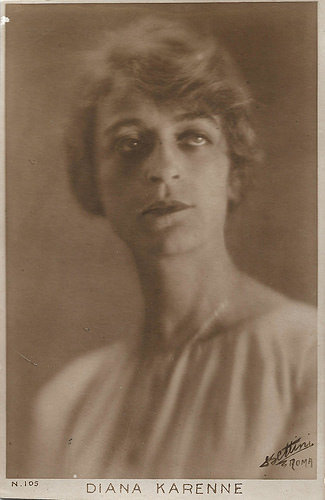
Diana Karenne . Italian postcard, no. 105. Photo: Bettini, Roma.
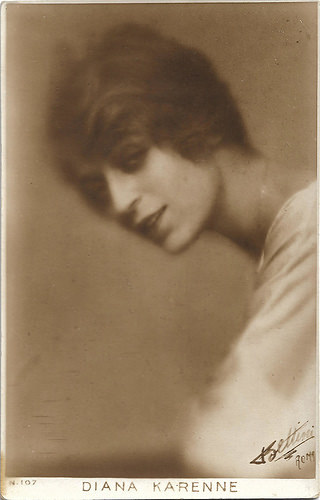
Diana Karenne . Italian postcard, no. 107. Photo: Bettini, Roma.
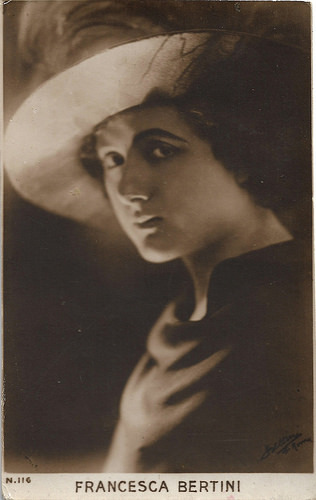
Francesca Bertini . Italian postcard, no. 116. Photo: Bettini, Roma.
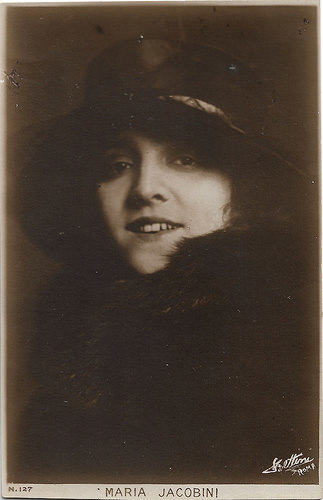
Maria Jacobini . Italian postcard, no. 127. Photo: Bettini, Roma.
A Family of Photographers
Dr. Carlo Napoleone Bettini, born in 1819 in Bologna, was forced to emigrate for his political beliefs to Egypt, where he worked as a photographer by applying the lessons he had learned in Paris from 1853 on, just for pleasure. In 1859, he was able to return to Italy when the political conditions changed at the beginning of the Second Italian War of Independence.
In Livorno, he opened Studio Felsineo. Some of his portraits of general Giuseppe Garibaldi are preserved now at the Museo del Risorgimento in Bologna. Bettini participated in the first National Exhibition of Florence in 1861 and around 1866 he became co-holder of the photo studio of C.B. Simelli in Rome.
Flanked by his son Ugo Bettini, born in Bologna in 1843, Carlo opened in 1866 another branch in Livorno, which became the main plant. Shortly after, Carlo left the entire business to his son. Ugo was a photo-chemical expert, who would become well known in the community of national photographers due to the success of his technical treatises. Ugo was a board member of the Italian Photographic Society, founded in Florence in 1889.
During the late 1890s, the Lumière brothers had some of their 'views' in Livorno shot by Bettini and his colleague Felicetti. The two operators, albeit with a still shot, treated the subject in a totally different ways. Despite the attribution to Felicetti (official photographer of the event) in the contemporary sources, some believe that Bettini was the Lumière operator present in Livorno, because Bettini never minded shooting film.
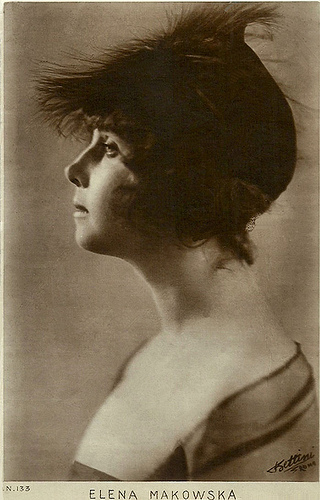
Helena Makowska . Italian postcard, no. 133. Photo: Bettini, Roma.
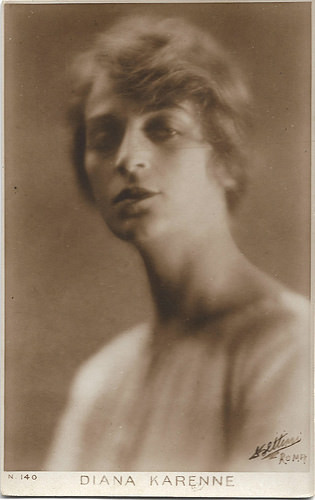
Diana Karenne . Italian postcard, no. 140. Photo: Bettini, Roma.
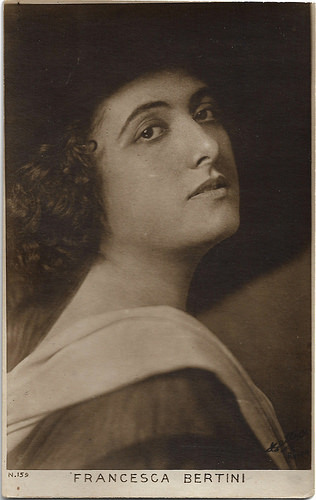
Francesca Bertini . Italian postcard, no. 159. Photo: Bettini, Roma.
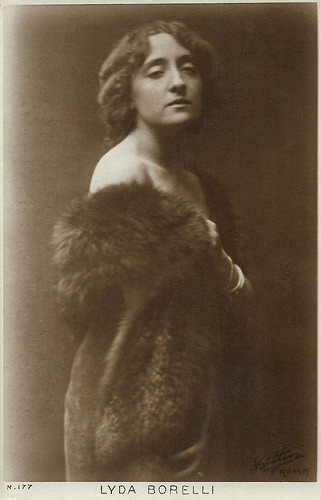
Lyda Borelli . Italian postcard, no. 177. Photo: Bettini, Roma.
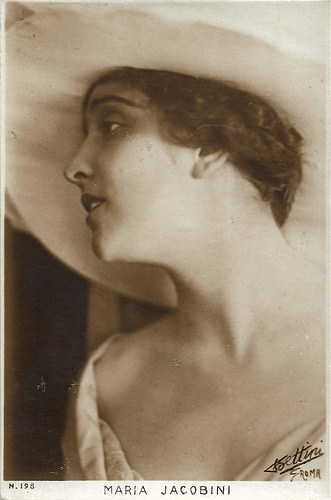
Maria Jacobini . Italian postcard, no. 198. Photo: Bettini, Roma.
The World of Culture
From the early 20th century, Ugo’s son, Cav. Dott. Riccardo Bettini, born in Livorno in 1878, started to keep up the family name in photography. He had a degree in chemistry. In 1908 Riccardo moved the studio to Rome, to Via del Mortaro 19. This had been the headquarters of the well known photo artist Henri Le Lieure. Riccardo took over the vast photo archive of Le Lieure, from his former days in Turin and Rome.
Bettini inherited the clientèle of Le Lieure: the aristocracy, the world of culture and that of politics. They came to Studio Le Lieure for photo portraits of themselves. Bettini participated in the International Exhibition of Photography in Dresden in 1909, was awarded an honorary diploma in 1911 at the Exhibition of Turin and that of Rome, and participated in the Third Italian Photographic Congress, held in Rome in 1911.
In the years between c. 1910-1930, Riccardo Bettini shared an art studio with Anton Giulio Bragaglia in Rome (Fotoritratti d’Arte Bettini Bragaglia). In 1924 he founded the Società anonima Ritratto Bettini to preserve and make known his powerful historical archive consisting of over 80,000 negatives.
The surviving core of the Bettini collection (some 3,000 glass negatives) was purchased in 1954 (some say 1958) by the City of Rome when Riccardo Bettini settled in Argentine. Bettini's collection is now hosted by the Archivio Fotografico Comunale.
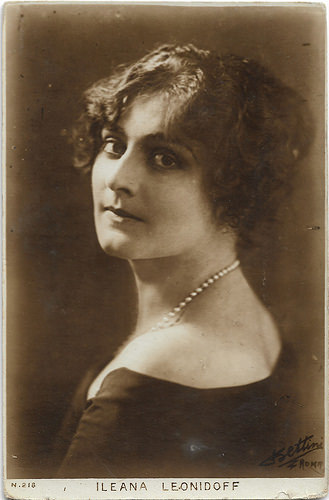
Ileana Leonidoff . Italian postcard, no. 218. Photo: Bettini, Roma.
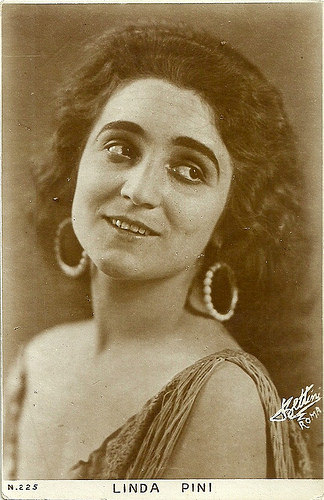
Linda Pini . Italian postcard, no. 225. Photo: Bettini, Roma.
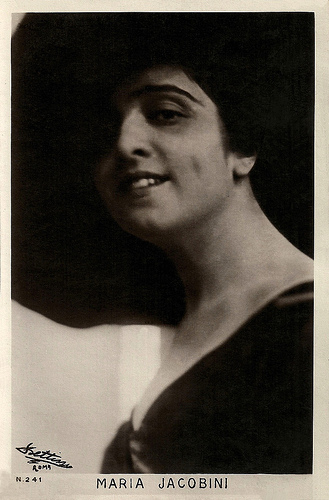
Maria Jacobini . Italian postcard, no. 241. Photo: Bettini, Roma.
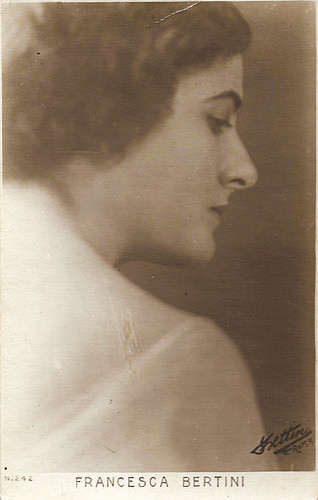
Francesca Bertini . Italian postcard, no. 242. Photo: Bettini, Roma.
Sources: Fotografi-in-italia-1839-1939 (Italian) and Il Museo di Roma racconta la città (Italian).

Diana Karenne . Italian postcard, no. 105. Photo: Bettini, Roma.

Diana Karenne . Italian postcard, no. 107. Photo: Bettini, Roma.

Francesca Bertini . Italian postcard, no. 116. Photo: Bettini, Roma.

Maria Jacobini . Italian postcard, no. 127. Photo: Bettini, Roma.
A Family of Photographers
Dr. Carlo Napoleone Bettini, born in 1819 in Bologna, was forced to emigrate for his political beliefs to Egypt, where he worked as a photographer by applying the lessons he had learned in Paris from 1853 on, just for pleasure. In 1859, he was able to return to Italy when the political conditions changed at the beginning of the Second Italian War of Independence.
In Livorno, he opened Studio Felsineo. Some of his portraits of general Giuseppe Garibaldi are preserved now at the Museo del Risorgimento in Bologna. Bettini participated in the first National Exhibition of Florence in 1861 and around 1866 he became co-holder of the photo studio of C.B. Simelli in Rome.
Flanked by his son Ugo Bettini, born in Bologna in 1843, Carlo opened in 1866 another branch in Livorno, which became the main plant. Shortly after, Carlo left the entire business to his son. Ugo was a photo-chemical expert, who would become well known in the community of national photographers due to the success of his technical treatises. Ugo was a board member of the Italian Photographic Society, founded in Florence in 1889.
During the late 1890s, the Lumière brothers had some of their 'views' in Livorno shot by Bettini and his colleague Felicetti. The two operators, albeit with a still shot, treated the subject in a totally different ways. Despite the attribution to Felicetti (official photographer of the event) in the contemporary sources, some believe that Bettini was the Lumière operator present in Livorno, because Bettini never minded shooting film.

Helena Makowska . Italian postcard, no. 133. Photo: Bettini, Roma.

Diana Karenne . Italian postcard, no. 140. Photo: Bettini, Roma.

Francesca Bertini . Italian postcard, no. 159. Photo: Bettini, Roma.

Lyda Borelli . Italian postcard, no. 177. Photo: Bettini, Roma.

Maria Jacobini . Italian postcard, no. 198. Photo: Bettini, Roma.
The World of Culture
From the early 20th century, Ugo’s son, Cav. Dott. Riccardo Bettini, born in Livorno in 1878, started to keep up the family name in photography. He had a degree in chemistry. In 1908 Riccardo moved the studio to Rome, to Via del Mortaro 19. This had been the headquarters of the well known photo artist Henri Le Lieure. Riccardo took over the vast photo archive of Le Lieure, from his former days in Turin and Rome.
Bettini inherited the clientèle of Le Lieure: the aristocracy, the world of culture and that of politics. They came to Studio Le Lieure for photo portraits of themselves. Bettini participated in the International Exhibition of Photography in Dresden in 1909, was awarded an honorary diploma in 1911 at the Exhibition of Turin and that of Rome, and participated in the Third Italian Photographic Congress, held in Rome in 1911.
In the years between c. 1910-1930, Riccardo Bettini shared an art studio with Anton Giulio Bragaglia in Rome (Fotoritratti d’Arte Bettini Bragaglia). In 1924 he founded the Società anonima Ritratto Bettini to preserve and make known his powerful historical archive consisting of over 80,000 negatives.
The surviving core of the Bettini collection (some 3,000 glass negatives) was purchased in 1954 (some say 1958) by the City of Rome when Riccardo Bettini settled in Argentine. Bettini's collection is now hosted by the Archivio Fotografico Comunale.

Ileana Leonidoff . Italian postcard, no. 218. Photo: Bettini, Roma.

Linda Pini . Italian postcard, no. 225. Photo: Bettini, Roma.

Maria Jacobini . Italian postcard, no. 241. Photo: Bettini, Roma.

Francesca Bertini . Italian postcard, no. 242. Photo: Bettini, Roma.
Sources: Fotografi-in-italia-1839-1939 (Italian) and Il Museo di Roma racconta la città (Italian).
Published on June 29, 2018 22:00
June 28, 2018
Cosetta Greco
Luciano Emmer 100: The Art of Gazing is one of the programmes we follow at Il Cinema Ritrovato 2018. Placed chronologically after Neorealism and before Commedia all’italiana, director Emmer’s works occupy a space of their own and possess great attention to detail and ambiance. He was the voice of young Roman characters and social groups in transition at the threshold of modernity, and Emmer made several inventive and original films that helped redefine the aesthetic tenets of Italian cinema. In his Le ragazze di Piazza di Spagna (1952), one of the three Roman Girls from the title was played by Cosetta Greco (1930-2002). This Italian film actress appeared in 31 films between 1943 and 1971.

Italian photocard. Photo Luxardo.

Italian postcard. Photo: LIF, Rotocalco Dagnino, Torino. Cosetta Greco in Il Brigante di Tacca del Lupo (Pietro Germi, 1952), based on the novel by Riccardo Bacchelli. Publicity card for the Manzoni cinema, Turin, where the film ran from 21 November [1952] onwards.
The love life of three beautiful Roman seamstresses
Cosetta Greco was born as Cesarina Rossi in Trento, Italy in 1930.
As a teenager, she took part in a competition for new actors by Scalera Film. Credited as Cesarina Rossi, she made her debut in the cinema with a small part as a chamber maid in Addio, amore!/Farewell, love! (Gianni Franciolini, 1943) starring Jacqueline Laurent and Clara Calamai .
Still credited as Cesarina Rossi, Greco played a young nun in the comedy La sposa non può attendere/The Bride Can't Wait (Gianni Franciolini, 1949), starring Gino Cervi and Gina Lollobrigida .
In 1951, she was chosen by director Pietro Germi for a major part in the crime film La città si difende/Four Ways Out (Pietro Germi, 1951), starring Gina Lollobrigida . Greco played the wife of one of four inexperienced criminals, who rob a stadium ticket booth during a big soccer game and then split up to try to hide separately.
The film follows their efforts to evade the police, complicated by the fact they are not professional criminals. La città si difende, co-written by Federico Fellini, won the award for Best Italian Film at the Venice International Film Festival in 1951.
The following year, she played the female lead in Germi's historical film Il brigante di Tacca del Lupo/The Bandit of Tacca Del Lupo (Pietro Germi, 1952). In 19th century southern Italy, a small force of soldiers lead by Captain Giordani ( Amedeo Nazzari ) fight in the hills against the bandits who are holding their country to ransom. The film was co-written by Federico Fellini, Germi and Tullio Pinelli.
Then she starred with Lucia Bosé and Liliana Bonfatti as three beautiful Roman seamstresses from one of the fashionable dress salons near the Piazza de Spagna in the classic comedy Le ragazze di piazza di Spagna/Three Girls from Rome (Luciano Emmer, 1952). The girls gather on the steps of the Piazza de Spagna to eat lunch and talk about their boy friends, including Renato Salvatori and Marcello Mastroianni .

Italian postcard by Bromostampa, Milano, no. 234. Photo: Dear Film.
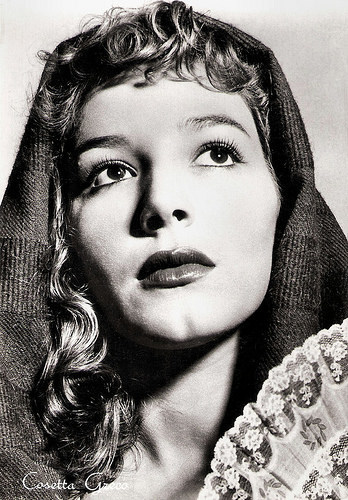
Italian postcard by Rotalfoto, Milano, no. 239.
Chronicle of a cynical prostitute
Cosetta Greco played a supporting part in the melodrama La Nemica/The Enemy (Giorgio Bianchi, 1952), starring Elisa Cegani, and that same year she co-starred with French actor Henri Vidal in Art. 519 codice penale/Article 519, Penal Code (Leonardo Cortese, 1952).
Another success was the soccer drama Gli eroi della domenica/Sunday Heroes (Mario Camerini, 1953), in which she played the only major female character between Raf Vallone , Marcello Mastroianni , Paolo Stoppa and Franco Interlenghi .
That year she also played the former wife of prisoner Daniel Gélin in the French-Italian drama La maison du silence/Voice of Silence (Georg Wilhelm Pabst, 1953), starring Aldo Fabrizi and Jean Marais .
Her last major success was Cronache di poveri amanti/Chronicle of Poor Lovers (Carlo Lizzani, 1954), in which she played cynical prostitute Elisa. She co-starred with Anna-Maria Ferrero , Antonella Lualdi and again Marcello Mastroianni . This drama was entered into the 1954 Cannes Film Festival.
Greco had a small part in the drama Gli innamorati/Wild Love (Mauro Bolognini, 1955), featuring real-life couple Antonella Lualdi and Franco Interlenghi . It was entered into the 1956 Cannes Film Festival.
In 1955, Greco also appeared in the Eddie Constantine crime film Je suis un sentimental/Headlines of Destruction (John Berry, 1955) and she was among the all-star cast of Napoléon (Sacha Guitry, 1955). She later appeared in the romantic drama I sogni nel cassetto/Dreams in a Drawer (Renato Castellani, 1957) starring Lea Massari.
Cosetta Greco was also active on television. In 1959, she appeared in the TV mini-series Il romanzo di un maestro/The novel of a master (Mario Landi, 1959). During the 1960s, she played Mata Hari in the TV mini-series Dossier Mata Hari (Mario Landi, 1967), opposite Gabriele Ferzetti .
Her last feature film was the Spaghetti Western Lo sceriffo di Rockspring/Sheriff of Rock Springs (Mario Sabatini, 1971) with Richard Harrison.
Cosetta Greco passed away in Rome in 2002. She was 71. She was married to Mario Cimica.
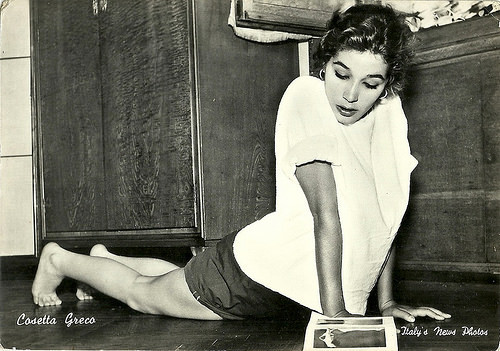
Italian postcard by Bromofoto, Milano, no. 1210.
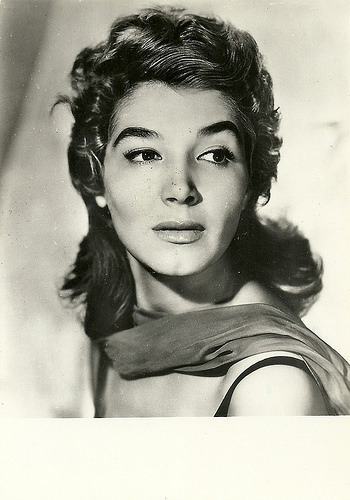
Italian postcard by Bromostampa, Milano in the Series 'Hobby'. This card could be posted to the star, asking to be returned with an autograph.
Sources: Wikipedia (Italian and English) and .

Italian photocard. Photo Luxardo.

Italian postcard. Photo: LIF, Rotocalco Dagnino, Torino. Cosetta Greco in Il Brigante di Tacca del Lupo (Pietro Germi, 1952), based on the novel by Riccardo Bacchelli. Publicity card for the Manzoni cinema, Turin, where the film ran from 21 November [1952] onwards.
The love life of three beautiful Roman seamstresses
Cosetta Greco was born as Cesarina Rossi in Trento, Italy in 1930.
As a teenager, she took part in a competition for new actors by Scalera Film. Credited as Cesarina Rossi, she made her debut in the cinema with a small part as a chamber maid in Addio, amore!/Farewell, love! (Gianni Franciolini, 1943) starring Jacqueline Laurent and Clara Calamai .
Still credited as Cesarina Rossi, Greco played a young nun in the comedy La sposa non può attendere/The Bride Can't Wait (Gianni Franciolini, 1949), starring Gino Cervi and Gina Lollobrigida .
In 1951, she was chosen by director Pietro Germi for a major part in the crime film La città si difende/Four Ways Out (Pietro Germi, 1951), starring Gina Lollobrigida . Greco played the wife of one of four inexperienced criminals, who rob a stadium ticket booth during a big soccer game and then split up to try to hide separately.
The film follows their efforts to evade the police, complicated by the fact they are not professional criminals. La città si difende, co-written by Federico Fellini, won the award for Best Italian Film at the Venice International Film Festival in 1951.
The following year, she played the female lead in Germi's historical film Il brigante di Tacca del Lupo/The Bandit of Tacca Del Lupo (Pietro Germi, 1952). In 19th century southern Italy, a small force of soldiers lead by Captain Giordani ( Amedeo Nazzari ) fight in the hills against the bandits who are holding their country to ransom. The film was co-written by Federico Fellini, Germi and Tullio Pinelli.
Then she starred with Lucia Bosé and Liliana Bonfatti as three beautiful Roman seamstresses from one of the fashionable dress salons near the Piazza de Spagna in the classic comedy Le ragazze di piazza di Spagna/Three Girls from Rome (Luciano Emmer, 1952). The girls gather on the steps of the Piazza de Spagna to eat lunch and talk about their boy friends, including Renato Salvatori and Marcello Mastroianni .

Italian postcard by Bromostampa, Milano, no. 234. Photo: Dear Film.

Italian postcard by Rotalfoto, Milano, no. 239.
Chronicle of a cynical prostitute
Cosetta Greco played a supporting part in the melodrama La Nemica/The Enemy (Giorgio Bianchi, 1952), starring Elisa Cegani, and that same year she co-starred with French actor Henri Vidal in Art. 519 codice penale/Article 519, Penal Code (Leonardo Cortese, 1952).
Another success was the soccer drama Gli eroi della domenica/Sunday Heroes (Mario Camerini, 1953), in which she played the only major female character between Raf Vallone , Marcello Mastroianni , Paolo Stoppa and Franco Interlenghi .
That year she also played the former wife of prisoner Daniel Gélin in the French-Italian drama La maison du silence/Voice of Silence (Georg Wilhelm Pabst, 1953), starring Aldo Fabrizi and Jean Marais .
Her last major success was Cronache di poveri amanti/Chronicle of Poor Lovers (Carlo Lizzani, 1954), in which she played cynical prostitute Elisa. She co-starred with Anna-Maria Ferrero , Antonella Lualdi and again Marcello Mastroianni . This drama was entered into the 1954 Cannes Film Festival.
Greco had a small part in the drama Gli innamorati/Wild Love (Mauro Bolognini, 1955), featuring real-life couple Antonella Lualdi and Franco Interlenghi . It was entered into the 1956 Cannes Film Festival.
In 1955, Greco also appeared in the Eddie Constantine crime film Je suis un sentimental/Headlines of Destruction (John Berry, 1955) and she was among the all-star cast of Napoléon (Sacha Guitry, 1955). She later appeared in the romantic drama I sogni nel cassetto/Dreams in a Drawer (Renato Castellani, 1957) starring Lea Massari.
Cosetta Greco was also active on television. In 1959, she appeared in the TV mini-series Il romanzo di un maestro/The novel of a master (Mario Landi, 1959). During the 1960s, she played Mata Hari in the TV mini-series Dossier Mata Hari (Mario Landi, 1967), opposite Gabriele Ferzetti .
Her last feature film was the Spaghetti Western Lo sceriffo di Rockspring/Sheriff of Rock Springs (Mario Sabatini, 1971) with Richard Harrison.
Cosetta Greco passed away in Rome in 2002. She was 71. She was married to Mario Cimica.

Italian postcard by Bromofoto, Milano, no. 1210.

Italian postcard by Bromostampa, Milano in the Series 'Hobby'. This card could be posted to the star, asking to be returned with an autograph.
Sources: Wikipedia (Italian and English) and .
Published on June 28, 2018 22:00
West Side Story (1961)
Every evening the public of Cinema Ritrovato gathers at the Piazza Maggiore for a spectacular open air screening. We won't miss West Side Story (1961). Buoyed by Robert Wise's dazzling direction, Leonard Bernstein's score, and Stephen Sondheim's lyrics, this musical remains perhaps the most iconic of all the Shakespeare adaptations. On its release, the film received high praise from critics and viewers, and became the second highest grossing film of the year in the United States.
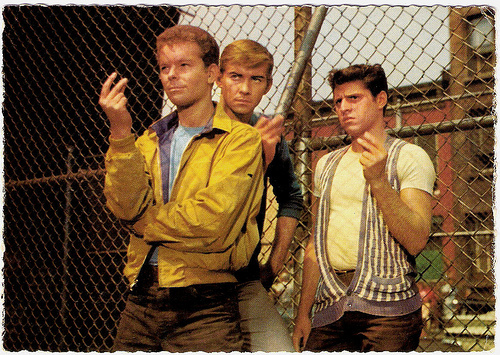
Vintage postcard. Publicity still for West Side Story (Robert Wise, Jerome Robbins, 1961) with Russ Tamblyn.
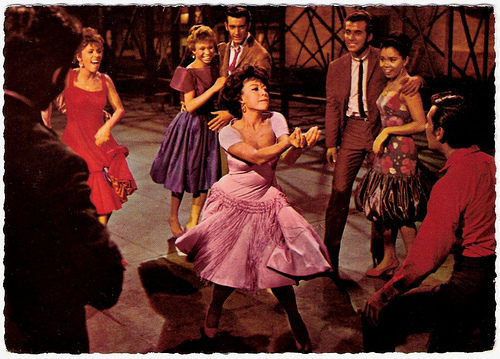
Dutch postcard. Photo: publicity still of Rita Moreno in West Side Story (Robert Wise, Jerome Robbins, 1961).
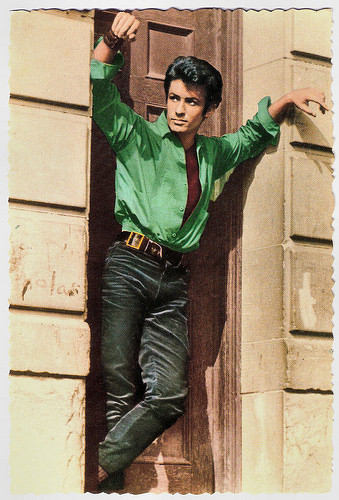
Spanish postcard by Archivo Bermejo, no. C. 65, 1963. Photo: United Artists. Publicity still of George Chakiris in West Side Story (Robert Wise, Jerome Robbins, 1961).
The Jets versus The Sharks
West Side Story (1961) is a classic American musical directed by Robert Wise and Jerome Robbins.
Two youngsters, played by Nathalie Wood and Richard Beymer, from two New York City gangs fall in love. The tensions between their gangs - the white Jets led by Riff (Russ Tamblyn) and the Puerto Rican Sharks, led by Bernardo ( George Chakiris ) - build toward tragedy.
The film is an adaptation of the 1957 Broadway musical of the same name, which in turn was inspired by William Shakespeare's play Romeo and Juliet. Veteran director Robert Wise was chosen to direct and produce because of his experience with urban New York dramas such as Odds Against Tomorrow (1959).
Since he had no experience directing a musical, Wise agreed that Jerome Robbins, who had directed the stage version of West Side Story, would direct the musical and dance sequences. After about one-third of the movie had been shot, the Mirisch Company, concerned that the production was running over-budget, dismissed Robbins. Robbins nearly suffered a nervous breakdown during the time he worked on the film.
The remaining dance numbers were directed with the help of Robbins' assistants. Recognising Robbins' considerable creative contribution to the film, Wise agreed that Robbins should be given co-directing credit, even though Wise directed the greater part of the film. The opening titles and end credits sequences were created by Saul Bass, who is also credited for 'visual consultation' on the film.
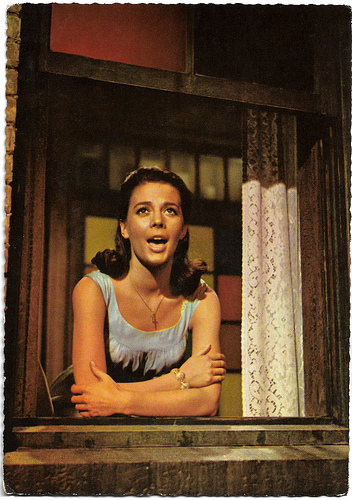
Dutch postcard by Gebr. Spanjersberg N.V., Rotterdam. Publicity still of Nathalie Wood in West Side Story (Robert Wise, Jerome Robbins, 1961).
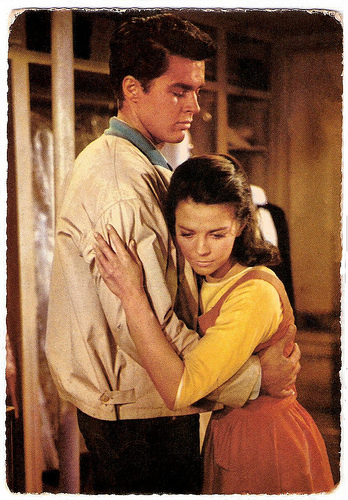
Dutch postcard by Gebr. Spanjersberg N.V., Rotterdam. Publicity still of Nathalie Wood and Richard Beymer in West Side Story (Robert Wise, Jerome Robbins, 1961).
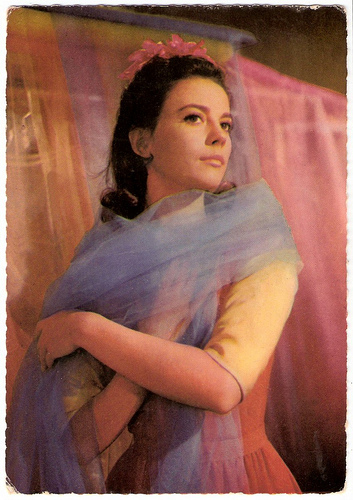
Dutch postcard. Photo: publicity still of Nathalie Wood in West Side Story (Robert Wise, Jerome Robbins, 1961).
Believable teenagers
West Side Story (1961) stars Natalie Wood, Richard Beymer, Russ Tamblyn, Rita Moreno, and George Chakiris .
Because the producers wanted actors who looked believable as teenagers, they did not consider 30-year-old Larry Kert, the first Tony on Broadway, or 29-year-old Carol Lawrence, the first Maria, but some actors in the cast had experience in stage productions.
Tony Mordente, who played A-Rab on stage, was cast as Action in the film, and George Chakiris , Riff in the London stage production, played Bernardo in the film.
For the role of Tony, the producers settled on five candidates: Warren Beatty, Anthony Perkins , Russ Tamblyn, Troy Donahue, and Richard Beymer. Although he was 28 before filming began, Perkins' boyish looks and Broadway resume seemed to make him a contender for the role.
Robert Wise originally chose Beatty for the role, figuring that youth was more important than experience. Ultimately, Beymer, the most unlikely of the candidates, won the part of Tony. Tamblyn, after several callbacks, impressed the producers and was given the role of Riff.
Natalie Wood was filming Splendor in the Grass (Elia Kazan, 1961) with Warren Beatty and was romantically involved with him off-screen. The producers were considering her for the role of Maria. When Beatty went to screen test for the role of Tony, Wood read opposite him as Maria as a favour because she had been practising with him. The producers fell in love with the idea of Wood as Maria but did not cast Beatty.
The film was nominated for 11 Academy Awards and won 10, including Best Picture and Best Supporting Actors awards for George Chakiris and Rita Moreno. This made West Side Story (1961) the musical film with the most Oscars, including Best Picture, ever.
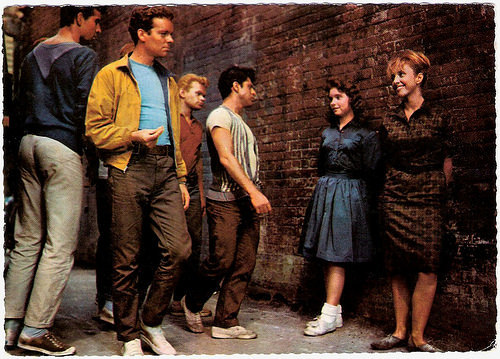
Vintage postcard. Publicity still for West Side Story (Robert Wise, Jerome Robbins, 1961) with Russ Ramblyn.
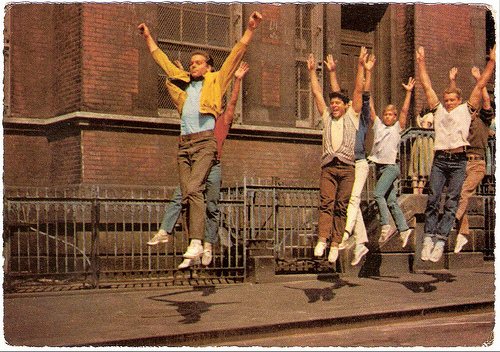
Vintage postcard. Publicity still for West Side Story (Robert Wise, Jerome Robbins, 1961) with Russ Ramblyn.
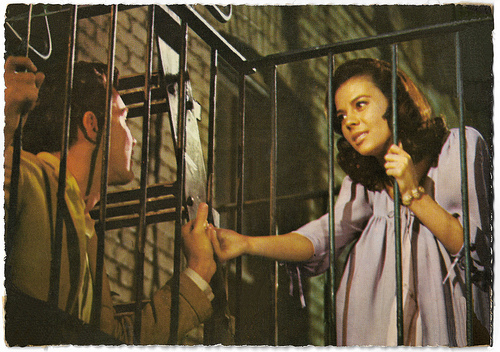
Dutch postcard by Gebr. Spanjersberg N.V., Rotterdam. Publicity still of Nathalie Wood and Richard Beymer in West Side Story (Robert Wise, Jerome Robbins, 1961).
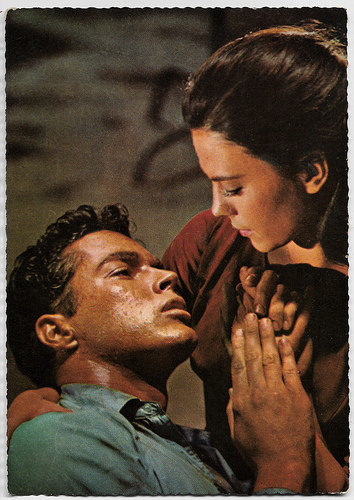
Dutch postcard by Gebr. Spanjersberg N.V., Rotterdam. Publicity still of Nathalie Wood and Richard Beymer in West Side Story (Robert Wise, Jerome Robbins, 1961).
Sources: Wikipedia and IMDb.

Vintage postcard. Publicity still for West Side Story (Robert Wise, Jerome Robbins, 1961) with Russ Tamblyn.

Dutch postcard. Photo: publicity still of Rita Moreno in West Side Story (Robert Wise, Jerome Robbins, 1961).

Spanish postcard by Archivo Bermejo, no. C. 65, 1963. Photo: United Artists. Publicity still of George Chakiris in West Side Story (Robert Wise, Jerome Robbins, 1961).
The Jets versus The Sharks
West Side Story (1961) is a classic American musical directed by Robert Wise and Jerome Robbins.
Two youngsters, played by Nathalie Wood and Richard Beymer, from two New York City gangs fall in love. The tensions between their gangs - the white Jets led by Riff (Russ Tamblyn) and the Puerto Rican Sharks, led by Bernardo ( George Chakiris ) - build toward tragedy.
The film is an adaptation of the 1957 Broadway musical of the same name, which in turn was inspired by William Shakespeare's play Romeo and Juliet. Veteran director Robert Wise was chosen to direct and produce because of his experience with urban New York dramas such as Odds Against Tomorrow (1959).
Since he had no experience directing a musical, Wise agreed that Jerome Robbins, who had directed the stage version of West Side Story, would direct the musical and dance sequences. After about one-third of the movie had been shot, the Mirisch Company, concerned that the production was running over-budget, dismissed Robbins. Robbins nearly suffered a nervous breakdown during the time he worked on the film.
The remaining dance numbers were directed with the help of Robbins' assistants. Recognising Robbins' considerable creative contribution to the film, Wise agreed that Robbins should be given co-directing credit, even though Wise directed the greater part of the film. The opening titles and end credits sequences were created by Saul Bass, who is also credited for 'visual consultation' on the film.

Dutch postcard by Gebr. Spanjersberg N.V., Rotterdam. Publicity still of Nathalie Wood in West Side Story (Robert Wise, Jerome Robbins, 1961).

Dutch postcard by Gebr. Spanjersberg N.V., Rotterdam. Publicity still of Nathalie Wood and Richard Beymer in West Side Story (Robert Wise, Jerome Robbins, 1961).

Dutch postcard. Photo: publicity still of Nathalie Wood in West Side Story (Robert Wise, Jerome Robbins, 1961).
Believable teenagers
West Side Story (1961) stars Natalie Wood, Richard Beymer, Russ Tamblyn, Rita Moreno, and George Chakiris .
Because the producers wanted actors who looked believable as teenagers, they did not consider 30-year-old Larry Kert, the first Tony on Broadway, or 29-year-old Carol Lawrence, the first Maria, but some actors in the cast had experience in stage productions.
Tony Mordente, who played A-Rab on stage, was cast as Action in the film, and George Chakiris , Riff in the London stage production, played Bernardo in the film.
For the role of Tony, the producers settled on five candidates: Warren Beatty, Anthony Perkins , Russ Tamblyn, Troy Donahue, and Richard Beymer. Although he was 28 before filming began, Perkins' boyish looks and Broadway resume seemed to make him a contender for the role.
Robert Wise originally chose Beatty for the role, figuring that youth was more important than experience. Ultimately, Beymer, the most unlikely of the candidates, won the part of Tony. Tamblyn, after several callbacks, impressed the producers and was given the role of Riff.
Natalie Wood was filming Splendor in the Grass (Elia Kazan, 1961) with Warren Beatty and was romantically involved with him off-screen. The producers were considering her for the role of Maria. When Beatty went to screen test for the role of Tony, Wood read opposite him as Maria as a favour because she had been practising with him. The producers fell in love with the idea of Wood as Maria but did not cast Beatty.
The film was nominated for 11 Academy Awards and won 10, including Best Picture and Best Supporting Actors awards for George Chakiris and Rita Moreno. This made West Side Story (1961) the musical film with the most Oscars, including Best Picture, ever.

Vintage postcard. Publicity still for West Side Story (Robert Wise, Jerome Robbins, 1961) with Russ Ramblyn.

Vintage postcard. Publicity still for West Side Story (Robert Wise, Jerome Robbins, 1961) with Russ Ramblyn.

Dutch postcard by Gebr. Spanjersberg N.V., Rotterdam. Publicity still of Nathalie Wood and Richard Beymer in West Side Story (Robert Wise, Jerome Robbins, 1961).

Dutch postcard by Gebr. Spanjersberg N.V., Rotterdam. Publicity still of Nathalie Wood and Richard Beymer in West Side Story (Robert Wise, Jerome Robbins, 1961).
Sources: Wikipedia and IMDb.
Published on June 28, 2018 22:00
June 26, 2018
Rita Hayworth in Gilda (1946)
Every evening the public of Cinema Ritrovato gathers at the Piazza Maggiore for a spectacular open air screening. One of these evening events is the screening of Gilda (Charles Vidor, 1946). Among the many attractions of this Film Noir is the sultry star of the film, Rita Hayworth. When she performs Put the Blame on Mame clad in lustrous black satin, she suggests a full striptease by only removing a glove. Gilda sealed Hayworth's reputation as Hollywood's leading love goddess of the 1940s.
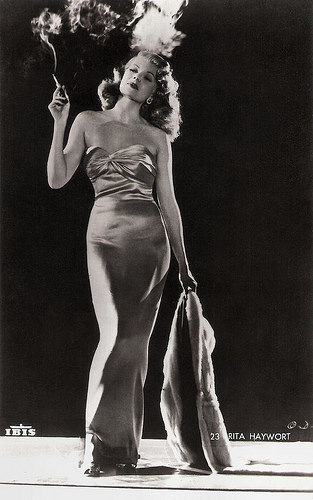
Vintage card by IBIS, no. 23. Photo: Columbia Pictures. Publicity still for Gilda (Charles Vidor, 1946).
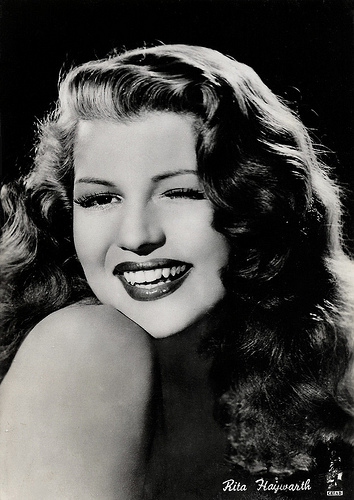
Italian postcard by Rotalfoto / Ediz. Garami, no. 54. Photo: Columbia Pictures / CEIAD. Publicity still for Gilda (Charles Vidor, 1946).
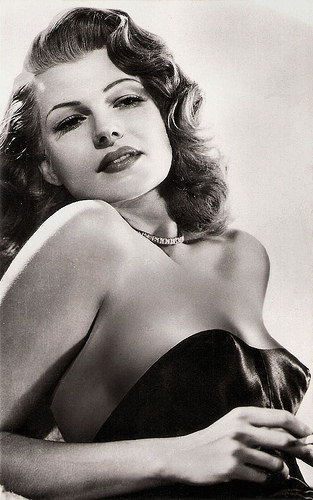
Spanish postcard, no. 4026. Photo: Columbia Pictures. Publicity still for Gilda (Charles Vidor, 1946).
Ultimate femme fatale
Rita Hayworth (1918-1987) was the Brooklyn-born daughter of Spanish dancer Eduardo Cansino and Ziegfeld Follies showgirl Volga Haworth. She joined her family on stage when she was eight years old when her family was filmed in a movie called La Fiesta (1926). In the 1930s films, she made a few films under her real name, Margarita Cansino, and with her real hair colour (black). Her beauty would catapult her to international stardom.
Over the next few years - at the urging of Columbia Studios and her first husband - she reshaped her hairline with electrolysis, dyed her hair auburn, and adopted the name Rita Hayworth. She had her breakthrough as an unfaithful wife opposite Cary Grant in Only Angels Have Wings (Howard Hawks, 1939). In 1941 Hayworth took the screen opposite James Cagney in Strawberry Blonde (Raoul Walsh, 1941). That same year the 'American film goddess' shared the dance floor with Fred Astaire in You'll Never Get Rich (Sidney Lanfield, 1941). Her splendid dancing with Astaire made her a star.
Hayworth played her signature role as Gilda Mundson Farrell, the ultimate femme fatale in the Film Noir Gilda (Charles Vidor, 1946), co-starring Glenn Ford as a small-time gambler and her former flame. The film was also noted for cinematographer Rudolph Maté's lush photography, costume designer Jean Louis's wardrobe for Hayworth (particularly for the dance numbers), and choreographer Jack Cole's staging of Put the Blame on Mame and Amado Mio, sung by Anita Ellis. Hayworth sang the acoustic guitar version of Put the Blame on Mame herself.
The following year she starred in another Film Noir favourite, The Lady From Shanghai (1948), which was directed by her then-husband, Orson Welles . The film is best remembered for its final sequence when the plot comes to a literally smashing climax in the famous 'hall of mirrors' sequence, with Hayworth and Welles shooting it out amidst shards of shattering glass.
Hayworth starred in more than fifteen films in the two following decades including Miss Sadie Thompson (Curtis Bernhardt, 1953), Pal Joey (George Sidney, 1957) with Frank Sinatra and Circus World (Henry Hathaway, 1964) for which she earned a Golden Globe nomination.
During the 1960s, she also appeared in some European films such as I Bastardi/The Cats (Duccio Tessari, 1968) with Giuliano Gemma and Claudine Auger , and Sur la Route de Salina/The Road to Salina (Georges Lautner, 1970). Her career ended with Ralph Nelson's satirical Western The Wrath of God (1972) opposite Robert Mitchum .
Hayworth was suffering from the first symptoms of Alzheimer's disease. For years, she would be cared for by her daughter Princess Yasmin Khan, and her death from the disease in 1987 gave it public attention that led to increased funding for medical research to find a cure.
Rita, herself, said about her most famous role, "Men fell in love with Gilda, but they wake up with me". In person, Rita Hayworth was shy, quiet and unassuming. Only when the cameras rolled did she turn on the explosive sexual charisma that in Gilda (1946) made her a superstar.
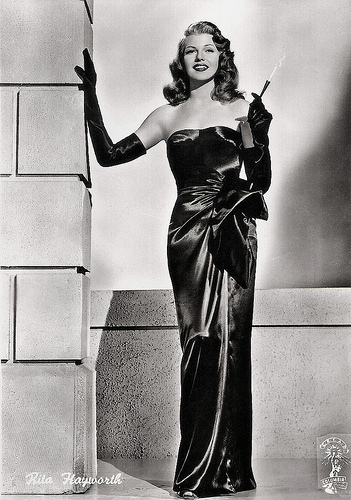
Italian postcard by Bromofoto, Milano, no. 237. Photo: Columbia Pictures. Publicity still for Gilda (Charles Vidor, 1946).
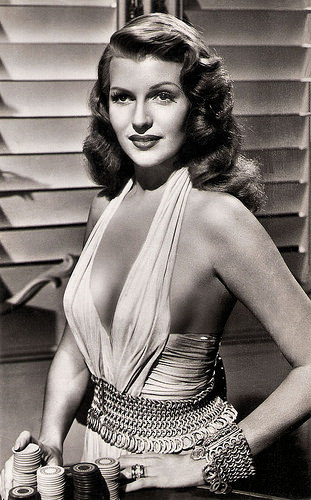
Spanish card in the series Hollywood California, no. 4027. Photo: Columbia Pictures. Publicity still for Gilda (Charles Vidor, 1946).
Trailer Gilda (1946). Source: Danios12345 (YouTube).
Source: Lucia Bozzola (AllMovie), AllMovie, bio, Wikipedia and .

Vintage card by IBIS, no. 23. Photo: Columbia Pictures. Publicity still for Gilda (Charles Vidor, 1946).

Italian postcard by Rotalfoto / Ediz. Garami, no. 54. Photo: Columbia Pictures / CEIAD. Publicity still for Gilda (Charles Vidor, 1946).

Spanish postcard, no. 4026. Photo: Columbia Pictures. Publicity still for Gilda (Charles Vidor, 1946).
Ultimate femme fatale
Rita Hayworth (1918-1987) was the Brooklyn-born daughter of Spanish dancer Eduardo Cansino and Ziegfeld Follies showgirl Volga Haworth. She joined her family on stage when she was eight years old when her family was filmed in a movie called La Fiesta (1926). In the 1930s films, she made a few films under her real name, Margarita Cansino, and with her real hair colour (black). Her beauty would catapult her to international stardom.
Over the next few years - at the urging of Columbia Studios and her first husband - she reshaped her hairline with electrolysis, dyed her hair auburn, and adopted the name Rita Hayworth. She had her breakthrough as an unfaithful wife opposite Cary Grant in Only Angels Have Wings (Howard Hawks, 1939). In 1941 Hayworth took the screen opposite James Cagney in Strawberry Blonde (Raoul Walsh, 1941). That same year the 'American film goddess' shared the dance floor with Fred Astaire in You'll Never Get Rich (Sidney Lanfield, 1941). Her splendid dancing with Astaire made her a star.
Hayworth played her signature role as Gilda Mundson Farrell, the ultimate femme fatale in the Film Noir Gilda (Charles Vidor, 1946), co-starring Glenn Ford as a small-time gambler and her former flame. The film was also noted for cinematographer Rudolph Maté's lush photography, costume designer Jean Louis's wardrobe for Hayworth (particularly for the dance numbers), and choreographer Jack Cole's staging of Put the Blame on Mame and Amado Mio, sung by Anita Ellis. Hayworth sang the acoustic guitar version of Put the Blame on Mame herself.
The following year she starred in another Film Noir favourite, The Lady From Shanghai (1948), which was directed by her then-husband, Orson Welles . The film is best remembered for its final sequence when the plot comes to a literally smashing climax in the famous 'hall of mirrors' sequence, with Hayworth and Welles shooting it out amidst shards of shattering glass.
Hayworth starred in more than fifteen films in the two following decades including Miss Sadie Thompson (Curtis Bernhardt, 1953), Pal Joey (George Sidney, 1957) with Frank Sinatra and Circus World (Henry Hathaway, 1964) for which she earned a Golden Globe nomination.
During the 1960s, she also appeared in some European films such as I Bastardi/The Cats (Duccio Tessari, 1968) with Giuliano Gemma and Claudine Auger , and Sur la Route de Salina/The Road to Salina (Georges Lautner, 1970). Her career ended with Ralph Nelson's satirical Western The Wrath of God (1972) opposite Robert Mitchum .
Hayworth was suffering from the first symptoms of Alzheimer's disease. For years, she would be cared for by her daughter Princess Yasmin Khan, and her death from the disease in 1987 gave it public attention that led to increased funding for medical research to find a cure.
Rita, herself, said about her most famous role, "Men fell in love with Gilda, but they wake up with me". In person, Rita Hayworth was shy, quiet and unassuming. Only when the cameras rolled did she turn on the explosive sexual charisma that in Gilda (1946) made her a superstar.

Italian postcard by Bromofoto, Milano, no. 237. Photo: Columbia Pictures. Publicity still for Gilda (Charles Vidor, 1946).

Spanish card in the series Hollywood California, no. 4027. Photo: Columbia Pictures. Publicity still for Gilda (Charles Vidor, 1946).
Trailer Gilda (1946). Source: Danios12345 (YouTube).
Source: Lucia Bozzola (AllMovie), AllMovie, bio, Wikipedia and .
Published on June 26, 2018 22:00
June 25, 2018
Alberto Capozzi
One of the programmes of Il Cinema Ritrovato is Arrigo Frusta and the Writing Workshop about the Italian Arrigo Frusta (1875-1965), the director of film company Ambrosio’s 'Screenplay Office'. With over 250 screenplays and scenarios, he made a decisive contribution to establishing the practice of writing for cinema during the crucial years of the advent of feature film. Il Cinema Ritrovato offers a sneak peek into the world of stories that this prolific screenwriter created, starting with a restored version of Nerone (1909). Star of the film is Alberto Capozzi (1886-1945), who had an enormous career in Italian films of the 1910s and early 1920s.
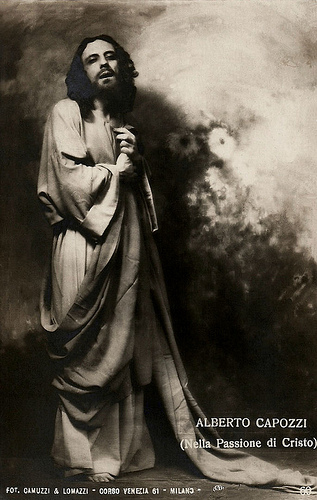
Italian postcard by Ed. A. Traldi, Milano, no. 69. Photo: Camuzzi & Lomazzi, Milano. Alberto Capozzi in the play La Passione di Cristo (1924). The retro marks a stamp 'Bonomelli, Milano. Palazzo dello Sport, La Passione di Cristo, 1924'.
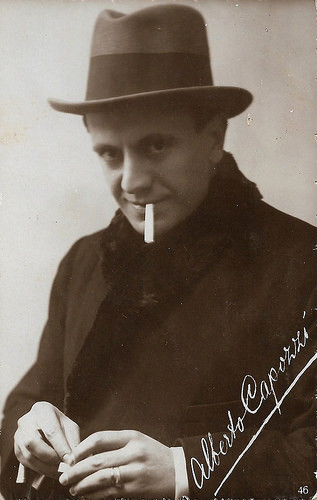
Italian postcard by Ed. A. Traldi, Milano, no. 46.
Wanted: major film actor
Alberto Angelo Capozzi was born in Genova, Italy in 1886. He was the son of ship-owner Pietro Capozzi and Emanuela Causa.
He spent his childhood in Sestri Ponente, and at the behest of his father he attended seminary, but wasn’t very convinced of this imposed vocation. Meanwhile, he discovered the existence of dramatic societies, like so many others. He began to play, fell in love with the craft, and demanded his parents to fall in love with it as well.
At sixteen, he managed to get enlisted by comedian Novelli Vidali, and felt like being in heaven. When he informed his father, the latter did not even comment on it, but went up to the comedian and broke up the enlisting and the stage future of his son. But Alberto didn’t give up and so, at seventeen he entered a stage company managed by a certain Musella, which he soon left for the more prestigious Talli-Borelli company, run by Virginio Talli, Lyda Borelli and Emma Grammatica .
In 1909, he read a newspaper ad in Il piccolo Faust, "Wanted: major film actor." Capozzi wrote to Arturo Ambrosio, the man of the ad, and got an invitation to come to Turin. Ambrosio received him together with Luigi Maggi, artistic director of the company, and they made him try a tragic death; at the time, the screen-test had not been born yet, so directors judged by the eye. When the test was over, Ambrosio offered him a contract at 300 lire a month.
Alberto accepted with evident enthusiasm. A few days later he acted in his first film, the historical film Spergiura!/The False Oath (Arturo Ambrosio, Luigi Maggi, 1909). He played a hussar, who courts a married lady and is walled up in a room. The film was a liberal adaptation of La Grande Bretêche by Honoré de Balzac and was an international success. It was the first of the Serie d’Oro (Golden Series), a series of prestigious historical productions by Ambrosio, which often starred Capozzi and his female co-star from Spergiura!, Mary Cleo Tarlarini.
The following years, Capozzi acted in countless short films. These included the epics Nerone/Nero (Luigi Maggi, 1909) with Capozzi as the Roman emperor, Didone abbondanata/Dido Forsaken by Aeneas (Luigi Maggi, 1910) with Capozzi as Aeneas, Lo schiavo di Cartagine/The Slave of Carthage (Arturo Ambrosio, Luigi Maggi, Roberto Omegna, 1910) which clearly precedes the plot of the epic Cabiria, and La vergine di Babilonia/The Virgin of Babylon (Luigi Maggi, 1910) with Mary Cleo Tarlarini in the title role.
Other films were the Western La cintura d’oro/The Golden Belt (1911), the Napoleonic films Il debito dell’Imperatore/The Emperor's Debt (Luigi Maggi, 1911) and Il granatiere Roland/Grenadier Roland (Luigi Maggi, 1911), the Gustave Flaubert adaptation Salambò/Salambo (Arturo Ambrosio, 1911), and the Risorgimento set drama Nozze d’oro (Luigi Maggi, 1911). All were part of the Serie d’Oro. Nozze d’oro even won first prize at the Turin International Film Contest in 1911. Ambrosio seemed satisfied, raising Capozzi’s salary first to 500, then to 800 lire a month.
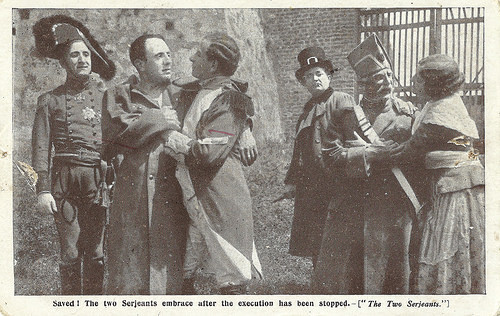
British postcard. Photo: Alberto Capozzi and Umberto Paradisi embrace in the Ambrosio production I due sergenti/The two Sergeants (Eugenio Perego, 1913).
The plot is about a Captain Derville (Capozzi) who unjustly accused of theft has to leave wife and children and disguises as a peasant named William. Because of bravery during the Napoleonic wars he is appointed sergeant. He bonds with sergeant Robert (Paradisi) but the jealous aide-de-camp Valmore (Giovanni Enrico Vidali), in love with Robert's fiancee Laura, plots to have both sergeants killed. When the two men transgress a quarantine in a time of plague, they are court-martialled and William has to die. William begs to say goodbye once more to his wife and children. Robert sacrifices himself to die instead of he doesn't return; Valmore doesn't mind this proposal. The evil Valmore even plots to delay William's return, but in the nick of time William returns, Robert is saved and the evil plotter is unmasked and condemned himself.
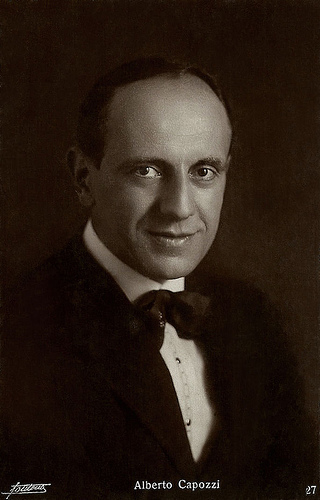
Italian postcard by Ed. A. Traldi, Milano, no. 27. Photo: Fontana.
Is it true that you gain 1200 lire a month?
In addition to these prestige films, Alberto Capozzi also acted for Ambrosio in several more modest modern short dramas. Examples are Alibi atroce/Truth Beyond Reach of Justice (Luigi Maggi, 1910), Il brutto sogno di una sartina/Alice's Awful Dream (N.N., 1911), and La tigre/The Human Tiger (Luigi Maggi, 1911).
He could also be seen in historical shorts, like L’ostaggio/The Hostage (Luigi Maggi, 1909), Il corriere dell’imperatore/The Emperor's Messenger (Luigi Maggi, 1910), and La pena del taglione/The Law of Retaliation (N.N., 1911). He even did romantic comedies such as Stratagemma d’amore/Love Tricks (N.N., 1910) with Gigetta Morano, and Il tramezzo/The Wall Partition (N.N., 1911) with Mary Cleo Tarlarini.
In 1911, the film company Pasquali grabbed Alberto away from Ambrosio, raising his salary to 1200 lire a month. Students stopped Capozzi on the street: “Is it true that you gain 1200 lire a month?” That year the long feature broke through, and while Capozzi already had acted in early features at Ambrosio such as L’ultimo dei Frontignac/The Last of the Frontignacs (Mario Caserini, 1911), he continued to do even more so at Pasquali in L’amore dello chauffeur/The love of the chauffeur (N.N., 1911) with Lydia De Roberti, Sui gradini del trono/On the Steps of the Throne (Ubaldo Maria Del Colle, 1912), and Bianco contro negro/The Iron Fist (Ubaldo Maria Del Colle, 1913), which, despite what IMDb writes, has nothing to do with William Shakespeare's Othello but with a white and a black boxer.
In 1914 Capozzi moved towards adventure and action features, often with co-stars like Cristina Ruspoli. Examples are Il supplizio dei leoni/A Journalist's Adventure (Luigi Mele or Eugenio Perego, 1914), and La maschera che sanguina/The mask that bleeds (Pier Angelo Mazzolotti, 1914). In addition to these features, Capozzi acted in many shorts at Pasquali, mainly in the years 1912-1913.
Capozzi’s name and face became well-known all over the globe. Meanwhile he continued to work at Ambrosio in 1912 but now as co-writer of the comedy Santarellina/Mam'selle Nitouche (Mario Caserini, 1912) starring Gigetta Morano, and the historical films Parsifal (Mario Caserini, 1912) and Siegfried (Mario Caserini, 1912).
From America and France to Russia, Poland and Africa, Alberto Capozzi was recognised as a famous film star, having millions of loyal admirers and swooning female fans. His films made crazy grosses, especially La rosa rossa/The Red Rose of the Apache (Luigi Maggi, 1912) with Mario Bonnard. With the gains of juat that film, Ernesto Maria Pasquali supposedly could build his new studios. Alberto received hundreds of letters from fans which he didn’t read, but passed on to director Nino Oxilia, who responded to the thousands. Meanwhile Gaumont called him to Paris and offered him a contract for 60,000 lires per year. But Pasquali offered him the same salary and Capozzi stayed in Turin.
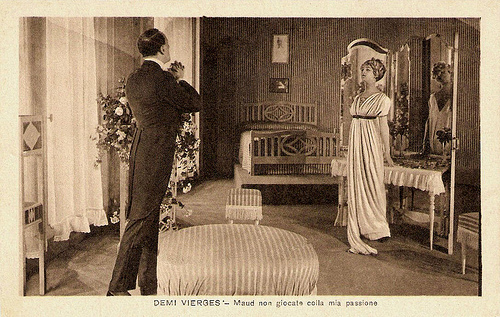
Italian postcard by IPA CT Duplex, no. 4038 Photo: Film Soc. An. Ambrosio, Torino. Publicity still for Il romanzo di Maud (Diana Karenne, 1917). Caption: "Maud, don't play with my passion", her lover Giuliano implores her ( Diana Karenne ).
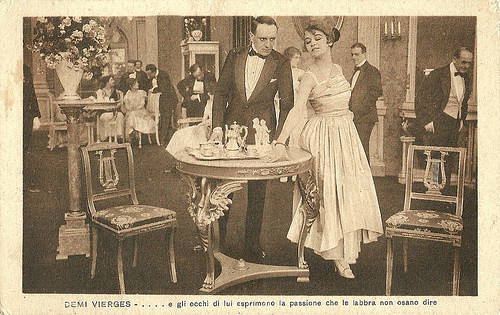
Italian postcard by IPA CT Duplefoto, no. 4041. Photo: Film Società Anonima Ambrosio, Torino. Diana Karenne in the Italian silent film Il romanzo di Maud aka Demi-vierges (Diana Karenne, 1917), based on Marcel Prévost's novel Demi-vierges, and directed by Diana Karenne herself. The film stars Karenne as Maud, while Alberto Capozzi plays Maxime and Francesco Cacace acts as Julien.
Huge crowds waited for him with music
After, the First World War broke out, Italy remained neutral at the start. Capozzi continued at Pasquali in films like Amore e cospirazione/Love and Conspiracy (Giovanni Enrico Vidali, 1915). In the same year, however, he must have gone back to Ambrosio, where he had his own ‘Capozzi series’. Several productions of this series were judged insufficient action and adventure films, such as Il Tesoro della cattedrale (Arturo Ambrosio Jr., 1915).
The press praised the veristic and well-performed Gli emigranti/The Emigrants (Gino Zaccaria, 1915), which co-starred Nilde Bruno, Capozzi’s regular female co-star in those years. The Emigrants might have been a sign, as Capozzi was offered the possibility to form a dramatic company to tour South America. The company started with a contract for three months, but according to the site In Penombra, the tour was so successful that they stayed overseas for a year. In Argentina everyone knew Capozzi, huge crowds waited for him with music.
It is not exactly known when and how long Capozzi stayed abroad, as he made several films in 1916 in Italy as well. With Diana Karenne , he played in the Pasquali production Oltre la vita, oltre la morte/Beyond life, beyond death (Ernesto Maria Pasquali, 1916). He acted in the Ambrosio film Straccetto/Rag (Filippo Costamagna, 1916), with Gigetta Morano and Elena Makowska . He also played in the Gladiator production Le rovine di un sogno/The ruins of a dream (Ugo De Simone, 1916).
In 1917 Capozzi played one of his most memorable parts in the Ambrosio production Fiacre No. 13, which he co-directed himself with Gero Zambuto. The film was based on Xavier de Montépin’s classic story. Count George de Latour (Vasco Creti), a spendthrift and gambler, decides to kill his brother and nephew in order to inherit their money. He is helped by his lover Berta Varny ( Elena Makowska ) and the apache Gian Giovedi (Capozzi).
The apache cannot kill the infant, so he hides it in an empty carriage, Fiacre No. 13. George and Berta enjoy their wealthy life until the boy has grown up and revenge takes place, with the help of Gian Giovedi. Berta is unmasked by the latter during a tableau vivant which reconstructs the fateful events. She kills herself, while George goes mad. The nephew is returned in possession of the riches stolen from him. While the first of the four episodes of the film was forbidden by the Italian censors, only the last episode remains, in a tinted version at the Cineteca Italiana. It was restored and presented at Il Cinema Ritrovato in 2001.
In 1917 Capozzi also acted in three films starring Diana Karenne , and all three directed by herself: La damina di Porcellana/The Little Porcelain Lady, Justice de femme/Female Justice, and Il romanzo di Maud/Semi Virgins. In 1918 he acted opposite Lyda Borelli and Livio Pavanelli in Borelli’s last film Una notte a Calcutta/A Night in Calcutta (Mario Caserini, 1918).
That year he also starred in a film directed by himself: La parabola di una vita/The story of a life (Alberto Capozzi, 1918). It is clear however, that in the late 1910s Capozzi’s performances were drastically reduced in number. In 1919-1922 he continued to act in films, but played just a few roles per year. He often was the male counterpart of female stars: subsequently Mina D’Orvella, Bianca Stagno Bellincioni, Lucy Di San Germano aka Lucy Sangermano, and the Hungarian actress Maria Corda - then known as Antonia Korda. The films with San Germano and Corda were directed by Alfredo De Antoni, who co-acted as the younger man in these films, opposite Capozzi as the by now older man. Scriptwriter for these films was the future director Nunzio Malasomma.
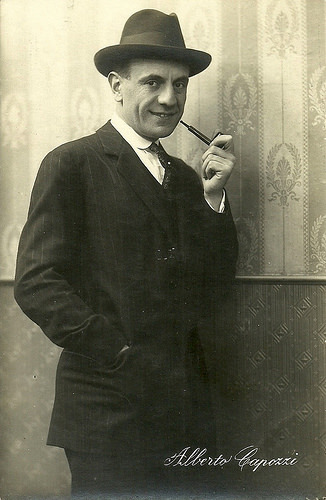
Italian postcard by G. Ballerini & C. Editori, Florence.
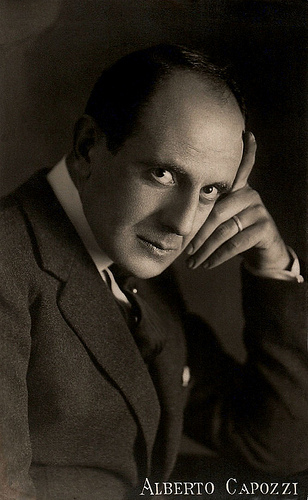
Italian postcard by Fotocelere, Torino.
But what an exciting one...
In 1920, Alberto Capozzi starred opposite Marie Doro in La principessa misteriosa/The Mysterious Princess by the Irish-American director Herbert Brenon. Possibly attracted by Maria Corda , Capozzi went to Austria in 1922 to act opposite Corda in Eine Versunkene Welt/A Vanished World (Alexander Korda, 1922) with Victor Varconi . He played a Habsburg archduke who enlists as an ordinary seaman. The film, based on the novel Serpoletto by Lajos Bíró, was shown at the 2009 Pordenone Silent Film Festival.
In 1922 Capozzi acted in only one other film, but what an exciting one: La casa sotto la neve/The cabin under the snow (Gennaro Righelli, 1922). Capozzi plays a doctor, Giorgio Salviati, who falls in love with Maria ( Maria Jacobini ), though she has a little daughter Grazia and is waiting for her lover Roberto to get married. The jealous Salviati steals Grazia to get Maria to an isolated cabin in the mountains, where he menaces the poor woman. During a snowstorm Roberto is just in time to save her. Even the incomplete print of the film is very impressing.
In 1924 Capozzi did his last silent film, Profanazione (Eugenio Perego, 1924), starring Leda Gys . The film was only released in 1926 after several cuts and had scarce distribution. In the mid-1920s Italian cinema was in crisis and in 1923 the UCI (Unione Cinematografica Italiana, a merger of former major companies like Ambrosio) went bankrupt.
Capozzi entered the theatre company of Tatiana Pavlova , which marked the 'professional' stage debut by Vittorio De Sica . Capozzi was first actor in the company of Pavlova, who experimented in Italy with bold conceptions of staging. In 1923, Capozzi appeared as a faded actor, both as comic character in Miss Hobbs by JK Jerome, at the Teatro Filodrammatici of Milan, and as a dramatic character in Romanzo by E. Sheldon, at the same theater.
The following year, after having left Pavlova, Capozzi personified the Redeemer, chanting nobly the gentle words of the Gospel, in The Passion of the Christ by A. Colantuoni. The costly show was first staged at the Palazzo dello Sport in Milan, then at the Teatro Adriano in Rome, where it sold out. In 1927 he joined the Borelli-Bertrame company and, once again, aroused interest from the theatre audiences. N. Leonelli said that his diction, though he strove to purify it, was affected by his roots of Genoa.
However, Capozzi would return to the cinema. During the early years of sound film (1929-1931), American productions were forbidden to be shown in Italy with English spoken dialogue. So scenes were added in which Italian actors, including Capozzi, said what had been said by the Americans up till then. Paramount invited him to Paris to do so in various films till 1932.
Then Alexander Korda lead him to London. There Capozzi could have had a lot of work, but the political atmosphere became ever more tense, so he returned to Italy shortly before the war. In the early 1940s Capozzi was highly active in Italian sound cinema, and played quite substantial parts in films like Marco Visconti (Mario Bonnard, 1941) starring Carlo Ninchi , La cena delle beffe/The dinner of the practical jokes (Alessandro Blasetti, 1942) starring Amedeo Nazzari, and Nessuna torna indietro/Responsibility Comes Back (Alessandro Blasetti, 1943) with Valentina Cortese .
Capozzi’s last part was in Alberto Lattuada’s La freccia nel fianco/The Arrow, starring Mariella Lotti . Shooting halted in September 1943, and was finished by Mario Costa after the liberation of Rome in 1944. The film was released after the death of Alberto Capozzi, who died in Rome in 1945. He was 58. All in all he acted in over 130 films between 1909 and 1943.
Prerview of Nerone (1909). Source: Harpodeon (YouTube).
Sources: Aldo Bernardini and Vittorio Martinelli (Il cinema muto italiano, 1905-1931 - Italian), Sempre in penombra (Italian), Treccani.it (Italian), Wikipedia (Italian) and .

Italian postcard by Ed. A. Traldi, Milano, no. 69. Photo: Camuzzi & Lomazzi, Milano. Alberto Capozzi in the play La Passione di Cristo (1924). The retro marks a stamp 'Bonomelli, Milano. Palazzo dello Sport, La Passione di Cristo, 1924'.

Italian postcard by Ed. A. Traldi, Milano, no. 46.
Wanted: major film actor
Alberto Angelo Capozzi was born in Genova, Italy in 1886. He was the son of ship-owner Pietro Capozzi and Emanuela Causa.
He spent his childhood in Sestri Ponente, and at the behest of his father he attended seminary, but wasn’t very convinced of this imposed vocation. Meanwhile, he discovered the existence of dramatic societies, like so many others. He began to play, fell in love with the craft, and demanded his parents to fall in love with it as well.
At sixteen, he managed to get enlisted by comedian Novelli Vidali, and felt like being in heaven. When he informed his father, the latter did not even comment on it, but went up to the comedian and broke up the enlisting and the stage future of his son. But Alberto didn’t give up and so, at seventeen he entered a stage company managed by a certain Musella, which he soon left for the more prestigious Talli-Borelli company, run by Virginio Talli, Lyda Borelli and Emma Grammatica .
In 1909, he read a newspaper ad in Il piccolo Faust, "Wanted: major film actor." Capozzi wrote to Arturo Ambrosio, the man of the ad, and got an invitation to come to Turin. Ambrosio received him together with Luigi Maggi, artistic director of the company, and they made him try a tragic death; at the time, the screen-test had not been born yet, so directors judged by the eye. When the test was over, Ambrosio offered him a contract at 300 lire a month.
Alberto accepted with evident enthusiasm. A few days later he acted in his first film, the historical film Spergiura!/The False Oath (Arturo Ambrosio, Luigi Maggi, 1909). He played a hussar, who courts a married lady and is walled up in a room. The film was a liberal adaptation of La Grande Bretêche by Honoré de Balzac and was an international success. It was the first of the Serie d’Oro (Golden Series), a series of prestigious historical productions by Ambrosio, which often starred Capozzi and his female co-star from Spergiura!, Mary Cleo Tarlarini.
The following years, Capozzi acted in countless short films. These included the epics Nerone/Nero (Luigi Maggi, 1909) with Capozzi as the Roman emperor, Didone abbondanata/Dido Forsaken by Aeneas (Luigi Maggi, 1910) with Capozzi as Aeneas, Lo schiavo di Cartagine/The Slave of Carthage (Arturo Ambrosio, Luigi Maggi, Roberto Omegna, 1910) which clearly precedes the plot of the epic Cabiria, and La vergine di Babilonia/The Virgin of Babylon (Luigi Maggi, 1910) with Mary Cleo Tarlarini in the title role.
Other films were the Western La cintura d’oro/The Golden Belt (1911), the Napoleonic films Il debito dell’Imperatore/The Emperor's Debt (Luigi Maggi, 1911) and Il granatiere Roland/Grenadier Roland (Luigi Maggi, 1911), the Gustave Flaubert adaptation Salambò/Salambo (Arturo Ambrosio, 1911), and the Risorgimento set drama Nozze d’oro (Luigi Maggi, 1911). All were part of the Serie d’Oro. Nozze d’oro even won first prize at the Turin International Film Contest in 1911. Ambrosio seemed satisfied, raising Capozzi’s salary first to 500, then to 800 lire a month.

British postcard. Photo: Alberto Capozzi and Umberto Paradisi embrace in the Ambrosio production I due sergenti/The two Sergeants (Eugenio Perego, 1913).
The plot is about a Captain Derville (Capozzi) who unjustly accused of theft has to leave wife and children and disguises as a peasant named William. Because of bravery during the Napoleonic wars he is appointed sergeant. He bonds with sergeant Robert (Paradisi) but the jealous aide-de-camp Valmore (Giovanni Enrico Vidali), in love with Robert's fiancee Laura, plots to have both sergeants killed. When the two men transgress a quarantine in a time of plague, they are court-martialled and William has to die. William begs to say goodbye once more to his wife and children. Robert sacrifices himself to die instead of he doesn't return; Valmore doesn't mind this proposal. The evil Valmore even plots to delay William's return, but in the nick of time William returns, Robert is saved and the evil plotter is unmasked and condemned himself.

Italian postcard by Ed. A. Traldi, Milano, no. 27. Photo: Fontana.
Is it true that you gain 1200 lire a month?
In addition to these prestige films, Alberto Capozzi also acted for Ambrosio in several more modest modern short dramas. Examples are Alibi atroce/Truth Beyond Reach of Justice (Luigi Maggi, 1910), Il brutto sogno di una sartina/Alice's Awful Dream (N.N., 1911), and La tigre/The Human Tiger (Luigi Maggi, 1911).
He could also be seen in historical shorts, like L’ostaggio/The Hostage (Luigi Maggi, 1909), Il corriere dell’imperatore/The Emperor's Messenger (Luigi Maggi, 1910), and La pena del taglione/The Law of Retaliation (N.N., 1911). He even did romantic comedies such as Stratagemma d’amore/Love Tricks (N.N., 1910) with Gigetta Morano, and Il tramezzo/The Wall Partition (N.N., 1911) with Mary Cleo Tarlarini.
In 1911, the film company Pasquali grabbed Alberto away from Ambrosio, raising his salary to 1200 lire a month. Students stopped Capozzi on the street: “Is it true that you gain 1200 lire a month?” That year the long feature broke through, and while Capozzi already had acted in early features at Ambrosio such as L’ultimo dei Frontignac/The Last of the Frontignacs (Mario Caserini, 1911), he continued to do even more so at Pasquali in L’amore dello chauffeur/The love of the chauffeur (N.N., 1911) with Lydia De Roberti, Sui gradini del trono/On the Steps of the Throne (Ubaldo Maria Del Colle, 1912), and Bianco contro negro/The Iron Fist (Ubaldo Maria Del Colle, 1913), which, despite what IMDb writes, has nothing to do with William Shakespeare's Othello but with a white and a black boxer.
In 1914 Capozzi moved towards adventure and action features, often with co-stars like Cristina Ruspoli. Examples are Il supplizio dei leoni/A Journalist's Adventure (Luigi Mele or Eugenio Perego, 1914), and La maschera che sanguina/The mask that bleeds (Pier Angelo Mazzolotti, 1914). In addition to these features, Capozzi acted in many shorts at Pasquali, mainly in the years 1912-1913.
Capozzi’s name and face became well-known all over the globe. Meanwhile he continued to work at Ambrosio in 1912 but now as co-writer of the comedy Santarellina/Mam'selle Nitouche (Mario Caserini, 1912) starring Gigetta Morano, and the historical films Parsifal (Mario Caserini, 1912) and Siegfried (Mario Caserini, 1912).
From America and France to Russia, Poland and Africa, Alberto Capozzi was recognised as a famous film star, having millions of loyal admirers and swooning female fans. His films made crazy grosses, especially La rosa rossa/The Red Rose of the Apache (Luigi Maggi, 1912) with Mario Bonnard. With the gains of juat that film, Ernesto Maria Pasquali supposedly could build his new studios. Alberto received hundreds of letters from fans which he didn’t read, but passed on to director Nino Oxilia, who responded to the thousands. Meanwhile Gaumont called him to Paris and offered him a contract for 60,000 lires per year. But Pasquali offered him the same salary and Capozzi stayed in Turin.

Italian postcard by IPA CT Duplex, no. 4038 Photo: Film Soc. An. Ambrosio, Torino. Publicity still for Il romanzo di Maud (Diana Karenne, 1917). Caption: "Maud, don't play with my passion", her lover Giuliano implores her ( Diana Karenne ).

Italian postcard by IPA CT Duplefoto, no. 4041. Photo: Film Società Anonima Ambrosio, Torino. Diana Karenne in the Italian silent film Il romanzo di Maud aka Demi-vierges (Diana Karenne, 1917), based on Marcel Prévost's novel Demi-vierges, and directed by Diana Karenne herself. The film stars Karenne as Maud, while Alberto Capozzi plays Maxime and Francesco Cacace acts as Julien.
Huge crowds waited for him with music
After, the First World War broke out, Italy remained neutral at the start. Capozzi continued at Pasquali in films like Amore e cospirazione/Love and Conspiracy (Giovanni Enrico Vidali, 1915). In the same year, however, he must have gone back to Ambrosio, where he had his own ‘Capozzi series’. Several productions of this series were judged insufficient action and adventure films, such as Il Tesoro della cattedrale (Arturo Ambrosio Jr., 1915).
The press praised the veristic and well-performed Gli emigranti/The Emigrants (Gino Zaccaria, 1915), which co-starred Nilde Bruno, Capozzi’s regular female co-star in those years. The Emigrants might have been a sign, as Capozzi was offered the possibility to form a dramatic company to tour South America. The company started with a contract for three months, but according to the site In Penombra, the tour was so successful that they stayed overseas for a year. In Argentina everyone knew Capozzi, huge crowds waited for him with music.
It is not exactly known when and how long Capozzi stayed abroad, as he made several films in 1916 in Italy as well. With Diana Karenne , he played in the Pasquali production Oltre la vita, oltre la morte/Beyond life, beyond death (Ernesto Maria Pasquali, 1916). He acted in the Ambrosio film Straccetto/Rag (Filippo Costamagna, 1916), with Gigetta Morano and Elena Makowska . He also played in the Gladiator production Le rovine di un sogno/The ruins of a dream (Ugo De Simone, 1916).
In 1917 Capozzi played one of his most memorable parts in the Ambrosio production Fiacre No. 13, which he co-directed himself with Gero Zambuto. The film was based on Xavier de Montépin’s classic story. Count George de Latour (Vasco Creti), a spendthrift and gambler, decides to kill his brother and nephew in order to inherit their money. He is helped by his lover Berta Varny ( Elena Makowska ) and the apache Gian Giovedi (Capozzi).
The apache cannot kill the infant, so he hides it in an empty carriage, Fiacre No. 13. George and Berta enjoy their wealthy life until the boy has grown up and revenge takes place, with the help of Gian Giovedi. Berta is unmasked by the latter during a tableau vivant which reconstructs the fateful events. She kills herself, while George goes mad. The nephew is returned in possession of the riches stolen from him. While the first of the four episodes of the film was forbidden by the Italian censors, only the last episode remains, in a tinted version at the Cineteca Italiana. It was restored and presented at Il Cinema Ritrovato in 2001.
In 1917 Capozzi also acted in three films starring Diana Karenne , and all three directed by herself: La damina di Porcellana/The Little Porcelain Lady, Justice de femme/Female Justice, and Il romanzo di Maud/Semi Virgins. In 1918 he acted opposite Lyda Borelli and Livio Pavanelli in Borelli’s last film Una notte a Calcutta/A Night in Calcutta (Mario Caserini, 1918).
That year he also starred in a film directed by himself: La parabola di una vita/The story of a life (Alberto Capozzi, 1918). It is clear however, that in the late 1910s Capozzi’s performances were drastically reduced in number. In 1919-1922 he continued to act in films, but played just a few roles per year. He often was the male counterpart of female stars: subsequently Mina D’Orvella, Bianca Stagno Bellincioni, Lucy Di San Germano aka Lucy Sangermano, and the Hungarian actress Maria Corda - then known as Antonia Korda. The films with San Germano and Corda were directed by Alfredo De Antoni, who co-acted as the younger man in these films, opposite Capozzi as the by now older man. Scriptwriter for these films was the future director Nunzio Malasomma.

Italian postcard by G. Ballerini & C. Editori, Florence.

Italian postcard by Fotocelere, Torino.
But what an exciting one...
In 1920, Alberto Capozzi starred opposite Marie Doro in La principessa misteriosa/The Mysterious Princess by the Irish-American director Herbert Brenon. Possibly attracted by Maria Corda , Capozzi went to Austria in 1922 to act opposite Corda in Eine Versunkene Welt/A Vanished World (Alexander Korda, 1922) with Victor Varconi . He played a Habsburg archduke who enlists as an ordinary seaman. The film, based on the novel Serpoletto by Lajos Bíró, was shown at the 2009 Pordenone Silent Film Festival.
In 1922 Capozzi acted in only one other film, but what an exciting one: La casa sotto la neve/The cabin under the snow (Gennaro Righelli, 1922). Capozzi plays a doctor, Giorgio Salviati, who falls in love with Maria ( Maria Jacobini ), though she has a little daughter Grazia and is waiting for her lover Roberto to get married. The jealous Salviati steals Grazia to get Maria to an isolated cabin in the mountains, where he menaces the poor woman. During a snowstorm Roberto is just in time to save her. Even the incomplete print of the film is very impressing.
In 1924 Capozzi did his last silent film, Profanazione (Eugenio Perego, 1924), starring Leda Gys . The film was only released in 1926 after several cuts and had scarce distribution. In the mid-1920s Italian cinema was in crisis and in 1923 the UCI (Unione Cinematografica Italiana, a merger of former major companies like Ambrosio) went bankrupt.
Capozzi entered the theatre company of Tatiana Pavlova , which marked the 'professional' stage debut by Vittorio De Sica . Capozzi was first actor in the company of Pavlova, who experimented in Italy with bold conceptions of staging. In 1923, Capozzi appeared as a faded actor, both as comic character in Miss Hobbs by JK Jerome, at the Teatro Filodrammatici of Milan, and as a dramatic character in Romanzo by E. Sheldon, at the same theater.
The following year, after having left Pavlova, Capozzi personified the Redeemer, chanting nobly the gentle words of the Gospel, in The Passion of the Christ by A. Colantuoni. The costly show was first staged at the Palazzo dello Sport in Milan, then at the Teatro Adriano in Rome, where it sold out. In 1927 he joined the Borelli-Bertrame company and, once again, aroused interest from the theatre audiences. N. Leonelli said that his diction, though he strove to purify it, was affected by his roots of Genoa.
However, Capozzi would return to the cinema. During the early years of sound film (1929-1931), American productions were forbidden to be shown in Italy with English spoken dialogue. So scenes were added in which Italian actors, including Capozzi, said what had been said by the Americans up till then. Paramount invited him to Paris to do so in various films till 1932.
Then Alexander Korda lead him to London. There Capozzi could have had a lot of work, but the political atmosphere became ever more tense, so he returned to Italy shortly before the war. In the early 1940s Capozzi was highly active in Italian sound cinema, and played quite substantial parts in films like Marco Visconti (Mario Bonnard, 1941) starring Carlo Ninchi , La cena delle beffe/The dinner of the practical jokes (Alessandro Blasetti, 1942) starring Amedeo Nazzari, and Nessuna torna indietro/Responsibility Comes Back (Alessandro Blasetti, 1943) with Valentina Cortese .
Capozzi’s last part was in Alberto Lattuada’s La freccia nel fianco/The Arrow, starring Mariella Lotti . Shooting halted in September 1943, and was finished by Mario Costa after the liberation of Rome in 1944. The film was released after the death of Alberto Capozzi, who died in Rome in 1945. He was 58. All in all he acted in over 130 films between 1909 and 1943.
Prerview of Nerone (1909). Source: Harpodeon (YouTube).
Sources: Aldo Bernardini and Vittorio Martinelli (Il cinema muto italiano, 1905-1931 - Italian), Sempre in penombra (Italian), Treccani.it (Italian), Wikipedia (Italian) and .
Published on June 25, 2018 22:00
June 24, 2018
15 x Marcello Mastroianni
One of the major programmes at Il Cinema Ritrovato this year is 'Portrait of Marcello Matroianni'. There are actors who, throughout their careers and their roles, shape for themselves a multi-faceted, indefinable personality, while others are faithful to their character from their first to their last film. And then, there’s Marcello Mastroianni. A one-of-a-kind performer, who was able to display a wealth of qualities and features that are hard to combine: a great actor and an icon, embodying at once elegance, empathy, sensitivity and light-hearted disenchantment. In line with this programme, EFSP presents fifteen postcards of Mastroianni's films throughout his long career.

Italian postcard by Bromofoto, Milano, no. 460. Photo: Atlantis Film. Publicity still for Febbre di vivere/Eager to Live (Claudio Gora, 1953).

Italian postcard by B.F.F. Edit., no. 3163. Photo: Titanus. Publicity still for La Bella Mugnaia/The Miller's Beautiful Wife (Mario Camerini, 1955).
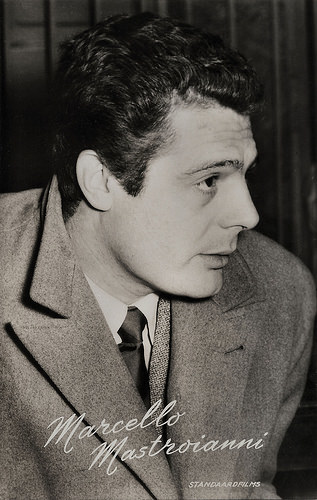
Dutch postcard by Uitg. Takken, no. AX 3203. Photo: Standaardfilms. Publicity still for Padri e figli.../Fathers and Sons (Mario Monicelli, 1957).
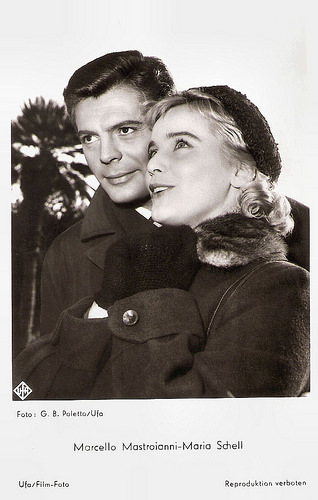
German postcard by Ufa, Berlin-Tempelhof, no. FK 3486. Photo: G.B. Poletto. Publicity still for Le notti bianche/ White Nights (Luchino Visconti, 1957) with Maria Schell .
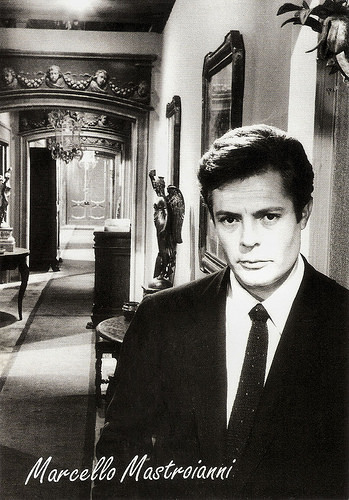
Italian postcard by Nuova Arti Grafiche Ricordi S.R.L. / Cinisello Balsamo, no. 2996, 1998. Photo: publicity still for Il bell' Antonio/Bell' Antonio (Mauro Bolognini, 1960).
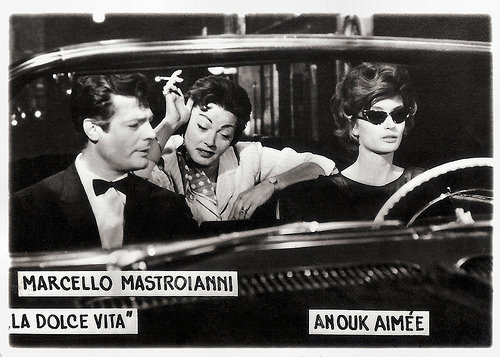
Small Romanian collectors card. Photo: publicity still for La Dolce Vita (Federico Fellini, 1960) with Amouk Aimée .

Small Romanian collectors card. Photo: publicity still for La Notte (Michelangelo Antonioni, 1961) with Jeanne Moreau .

Small Czech collectors card by Pressfoto, Praha (Prague), 1965, no. S 83/6. Publicity still for Divorzio all'italiana/Divorce, Italian Style (Pietro Germi, 1961) with Stefania Sandrelli .
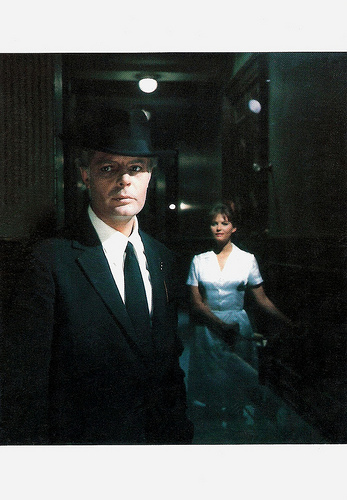
French postcard by Edition La Malibran, Paris, no. MC 38, 1990. Photo: Claude Schwartz. Publicity still for Otto e Mezzo/8½ (Federico Fellini, 1963) with Claudia Cardinale .

East-German postcard by VEB Progress Film-Vertrieb, Berlin, no. 2634. Photo: publicity still for Matrimonio all'italiana/Marriage Italian Style (Vittorio De Sica, 1964).
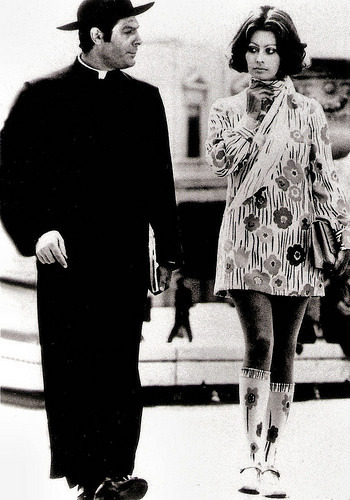
German postcard by pwe Verlag, München (Munich). Photo: publicity still for La moglie del prete/The Priest's Wife (Dino Risi, 1970) with Sophia Loren .
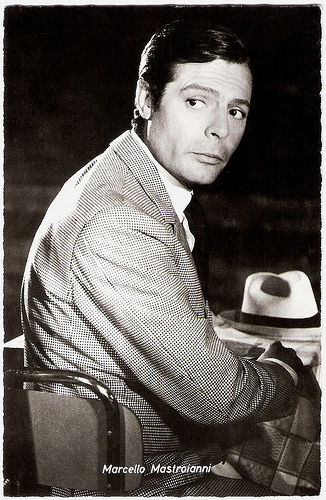
German postcard by Friedrich W. Sander Verlag, Minden. Photo: Inter Film. Still for Casanova 70 (Mario Monicelli, 1970).
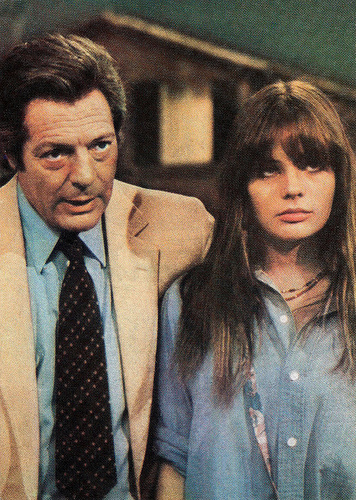
Romanian postcard by Casa Filmului Acin. Photo: publicity still for La terrazza (Ettore Scola, 1980) with Marie Trintignant.

Romanian postcard by Casa Filmului Acin. Photo: publicity still for Enrico IV/Henry IV (Marco Bellocchio, 1984).
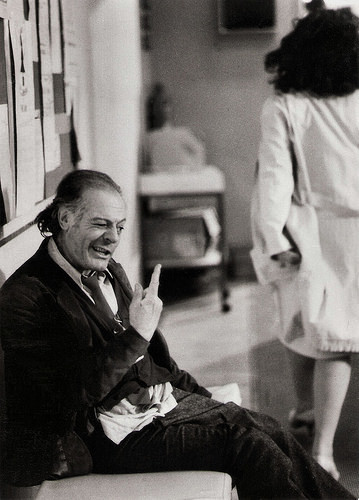
German press photo, no. 5. Photo: Tobis. Publicity still for Ginger e Fred (Federico Fellini, 1986).

Italian postcard by Bromofoto, Milano, no. 460. Photo: Atlantis Film. Publicity still for Febbre di vivere/Eager to Live (Claudio Gora, 1953).

Italian postcard by B.F.F. Edit., no. 3163. Photo: Titanus. Publicity still for La Bella Mugnaia/The Miller's Beautiful Wife (Mario Camerini, 1955).

Dutch postcard by Uitg. Takken, no. AX 3203. Photo: Standaardfilms. Publicity still for Padri e figli.../Fathers and Sons (Mario Monicelli, 1957).

German postcard by Ufa, Berlin-Tempelhof, no. FK 3486. Photo: G.B. Poletto. Publicity still for Le notti bianche/ White Nights (Luchino Visconti, 1957) with Maria Schell .

Italian postcard by Nuova Arti Grafiche Ricordi S.R.L. / Cinisello Balsamo, no. 2996, 1998. Photo: publicity still for Il bell' Antonio/Bell' Antonio (Mauro Bolognini, 1960).

Small Romanian collectors card. Photo: publicity still for La Dolce Vita (Federico Fellini, 1960) with Amouk Aimée .

Small Romanian collectors card. Photo: publicity still for La Notte (Michelangelo Antonioni, 1961) with Jeanne Moreau .

Small Czech collectors card by Pressfoto, Praha (Prague), 1965, no. S 83/6. Publicity still for Divorzio all'italiana/Divorce, Italian Style (Pietro Germi, 1961) with Stefania Sandrelli .

French postcard by Edition La Malibran, Paris, no. MC 38, 1990. Photo: Claude Schwartz. Publicity still for Otto e Mezzo/8½ (Federico Fellini, 1963) with Claudia Cardinale .

East-German postcard by VEB Progress Film-Vertrieb, Berlin, no. 2634. Photo: publicity still for Matrimonio all'italiana/Marriage Italian Style (Vittorio De Sica, 1964).

German postcard by pwe Verlag, München (Munich). Photo: publicity still for La moglie del prete/The Priest's Wife (Dino Risi, 1970) with Sophia Loren .

German postcard by Friedrich W. Sander Verlag, Minden. Photo: Inter Film. Still for Casanova 70 (Mario Monicelli, 1970).

Romanian postcard by Casa Filmului Acin. Photo: publicity still for La terrazza (Ettore Scola, 1980) with Marie Trintignant.

Romanian postcard by Casa Filmului Acin. Photo: publicity still for Enrico IV/Henry IV (Marco Bellocchio, 1984).

German press photo, no. 5. Photo: Tobis. Publicity still for Ginger e Fred (Federico Fellini, 1986).
Published on June 24, 2018 22:00
June 23, 2018
Gene Tierney
We're in Bologna, Italy, at the 32nd edition of Il Cinema Ritrovato! One of the programmes is 'Immortal Imitations: The Cinema of John M. Stahl'. Stahl's films treat concealed identities, troubled yet enduring love affairs, tragic destinies assuaged by altruism and sacrifice… Highlight is Leave Her to Heaven (1945), for which leading lady Gene Tierney received an Oscar nomination. With prominent cheekbones and the most appealing overbite of her day, her striking good looks helped propel the American actress to stardom. Her best known role is probably the enigmatic murder victim in Laura (1944). In the 1950s, her acting performances were few as she battled a troubled emotional life that included hospitalisation and shock treatment for depression.
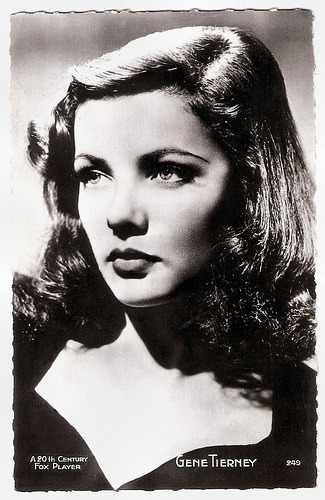
French postcard by Editions P.I., no. 49. Photo: 20th Century Fox.
The most beautiful water carrier ever
In 1920, Gene Tierney was born in Brooklyn, New York, to well-to-do parents. Her father was a very successful insurance broker and her mother was a former teacher. She lived, at times, with her equally successful grandparents in Connecticut and New York. Gene was educated in the finest schools on the East Coast. Tierney played Jo in a student production of Little Women, based on the novel by Louisa May Alcott. After two years at a finishing school in Lausanne, Switzerland, she returned to the US where she completed her education.
Her wealthy father set up a corporation that was only to promote her theatrical pursuits. By 1938 Tierney was performing on Broadway in What a Life! and understudied for The Primerose Path (1938) at the same time. Her first role consisted of carrying a bucket of water across the stage, prompting a Variety magazine critic to announce that "Miss Tierney is, without a doubt, the most beautiful water carrier I have ever seen!"
Her subsequent roles in Mrs O'Brian Entertains (1939) and RingTwo (1939) were meatier and received praise from the New York critics. Critic Richard Watts of the New York Herald Tribune wrote: "I see no reason why Miss Tierney should not have a long and interesting theatrical career, that is if the cinema does not kidnap her away".
Before her 20th birthday, Gene Tierney was the toast of Broadway. The play The Male Animal (1940) was a hit, and Tierney was featured in Life magazine. She was also photographed by Harper's Bazaar, Vogue, and Collier's Weekly.
After being spotted by the legendary Darryl F. Zanuck during a stage performance of The Male Animal, Gene was signed to a contract with 20th Century-Fox. Her first role as Barbara Hall in Hudson's Bay (Irving Pichel, 1941) would be the send-off vehicle for her career. Later that year she appeared in the Western The Return of Frank James (Fritz Lang, 1940) opposite Henry Fonda.
1941 would prove to be a very busy year for Gene Tierney, as she appeared in The Shanghai Gesture (Josef von Sternberg, 1941) with Walter Huston, Sundown (Henry Hathaway, 1941), Tobacco Road (John Ford, 1941) and Belle Starr (Irving Cummings, 1941) with Randolph Scott.
She tried her hand at screwball comedy in Rings on Her Fingers (Rouben Mamoulian, 1942) with Henry Fonda, which was a great success. Another success was the comedy Heaven Can Wait (Ernst Lubitsch, 1943) with Don Ameche as a man who has to prove he belongs in Hell by telling his life story. Her performances in each of these productions were masterful.
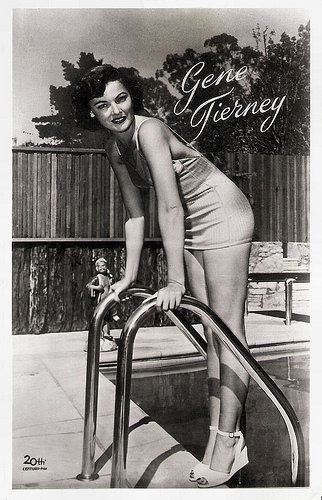
Dutch postcard. Photo: 20th Century Fox.
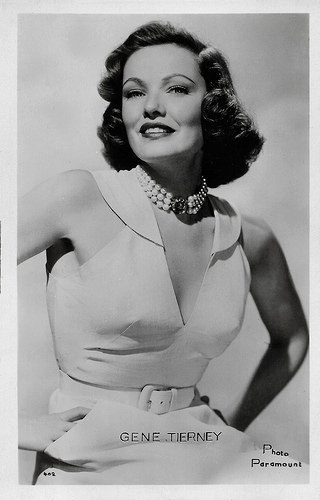
French postcard by Editions P.I., no. 49. Photo: Paramount.
The hottest player around
In 1944, Gene Tierney played what is probably her best-known role (and, most critics agree, her most outstanding performance) in Otto Preminger's Film Noir Laura (1944), in which she played a murder victim named Laura Hunt.
The following year, she was nominated for a Best Actress Oscar for her portrayal of the jealous, narcissistic femme fatale Ellen Berent Harland in Leave Her to Heaven (John M. Stahl, 1945). Though she didn't win, it solidified her position in Hollywood society. This was 20th Century-Fox' most successful film of the 1940s. It was cited by director Martin Scorsese as one of his favourite films of all time, and he assessed Tierney as one of the most underrated actresses of the Golden Era.
She followed up with another great performance as Isabel Bradley in the hit The Razor's Edge (Edmund Goulding, 1946) starring Tyrone Power . In 1947, Gene played Lucy Muir in the acclaimed comedy The Ghost and Mrs. Muir (Joseph L. Mankiewicz, 1947) opposite Rex Harrison .
By this time Gene Tierney was the hottest player around, and the 1950s saw no letup as she appeared in a number of good films, among them Night and the City (Jules Dassin, 1950) with Richard Widmark, The Mating Season (Mitchell Leisen, 1951), Close to My Heart (William Keigley, 1951) opposite Ray Milland , and Plymouth Adventure (Clarence Brown, 1952) starring Spencer Tracey.
In Great Britain, she appeared in the film Personal Affair (Anthony Pelissier, 1953) with Leo Genn. Then The Left Hand of God (Edward Dmytryk, 1955), in which she starred opposite Humphrey Bogart, was to be her last performance for seven years.
The pressures of a failed marriage to American fashion designer Oleg Cassini, the birth of an intellectually disabled daughter, and several unhappy love affairs, including a notorious one with John F. Kennedy, resulted in a deep depression. Her daughter Daria was born disabled because Tierney had contracted rubella (aka German measles) during her only appearance at the Hollywood Canteen.
In late December 1957, Tierney, from her mother's apartment in Manhattan, stepped onto a ledge 14 stories above ground and remained for about 20 minutes in what was considered a suicide attempt. Tierney's family arranged for her to be admitted to the Menninger Clinic in Topeka, Kansas. The following year, after treatment for depression, she was released.
When she returned to the the screen in Advise & Consent (Otto Preminger, 1962), her acting was as good as ever but there was no longer a big demand for her services. Her last feature film was The Pleasure Seekers (Jean Negulesco, 1964) starring Ann-Margret , and her final appearance in the film industry was in a TV miniseries, Scruples (Alan J. Levi, 1980).
Gene Tierney died of emphysema in Houston, Texas, in 1991, just two weeks before her 71st birthday. She had two daughters from her first marriage to Oleg Cassini, Antoinette Daria Cassini and Christina Cassini. From 1960 on, she was married to William Howard Lee. He was originally married to Hedy Lamarr before he married Tierney.
Trailer Laura (1944). Source: Chloroform and Silver Nitrate (YouTube).
Trailer Leave Her to Heaven (1945). Source: Cliff Held (YouTube).
Sources: (IMDb), (IMDb), Wikipedia and .

French postcard by Editions P.I., no. 49. Photo: 20th Century Fox.
The most beautiful water carrier ever
In 1920, Gene Tierney was born in Brooklyn, New York, to well-to-do parents. Her father was a very successful insurance broker and her mother was a former teacher. She lived, at times, with her equally successful grandparents in Connecticut and New York. Gene was educated in the finest schools on the East Coast. Tierney played Jo in a student production of Little Women, based on the novel by Louisa May Alcott. After two years at a finishing school in Lausanne, Switzerland, she returned to the US where she completed her education.
Her wealthy father set up a corporation that was only to promote her theatrical pursuits. By 1938 Tierney was performing on Broadway in What a Life! and understudied for The Primerose Path (1938) at the same time. Her first role consisted of carrying a bucket of water across the stage, prompting a Variety magazine critic to announce that "Miss Tierney is, without a doubt, the most beautiful water carrier I have ever seen!"
Her subsequent roles in Mrs O'Brian Entertains (1939) and RingTwo (1939) were meatier and received praise from the New York critics. Critic Richard Watts of the New York Herald Tribune wrote: "I see no reason why Miss Tierney should not have a long and interesting theatrical career, that is if the cinema does not kidnap her away".
Before her 20th birthday, Gene Tierney was the toast of Broadway. The play The Male Animal (1940) was a hit, and Tierney was featured in Life magazine. She was also photographed by Harper's Bazaar, Vogue, and Collier's Weekly.
After being spotted by the legendary Darryl F. Zanuck during a stage performance of The Male Animal, Gene was signed to a contract with 20th Century-Fox. Her first role as Barbara Hall in Hudson's Bay (Irving Pichel, 1941) would be the send-off vehicle for her career. Later that year she appeared in the Western The Return of Frank James (Fritz Lang, 1940) opposite Henry Fonda.
1941 would prove to be a very busy year for Gene Tierney, as she appeared in The Shanghai Gesture (Josef von Sternberg, 1941) with Walter Huston, Sundown (Henry Hathaway, 1941), Tobacco Road (John Ford, 1941) and Belle Starr (Irving Cummings, 1941) with Randolph Scott.
She tried her hand at screwball comedy in Rings on Her Fingers (Rouben Mamoulian, 1942) with Henry Fonda, which was a great success. Another success was the comedy Heaven Can Wait (Ernst Lubitsch, 1943) with Don Ameche as a man who has to prove he belongs in Hell by telling his life story. Her performances in each of these productions were masterful.

Dutch postcard. Photo: 20th Century Fox.

French postcard by Editions P.I., no. 49. Photo: Paramount.
The hottest player around
In 1944, Gene Tierney played what is probably her best-known role (and, most critics agree, her most outstanding performance) in Otto Preminger's Film Noir Laura (1944), in which she played a murder victim named Laura Hunt.
The following year, she was nominated for a Best Actress Oscar for her portrayal of the jealous, narcissistic femme fatale Ellen Berent Harland in Leave Her to Heaven (John M. Stahl, 1945). Though she didn't win, it solidified her position in Hollywood society. This was 20th Century-Fox' most successful film of the 1940s. It was cited by director Martin Scorsese as one of his favourite films of all time, and he assessed Tierney as one of the most underrated actresses of the Golden Era.
She followed up with another great performance as Isabel Bradley in the hit The Razor's Edge (Edmund Goulding, 1946) starring Tyrone Power . In 1947, Gene played Lucy Muir in the acclaimed comedy The Ghost and Mrs. Muir (Joseph L. Mankiewicz, 1947) opposite Rex Harrison .
By this time Gene Tierney was the hottest player around, and the 1950s saw no letup as she appeared in a number of good films, among them Night and the City (Jules Dassin, 1950) with Richard Widmark, The Mating Season (Mitchell Leisen, 1951), Close to My Heart (William Keigley, 1951) opposite Ray Milland , and Plymouth Adventure (Clarence Brown, 1952) starring Spencer Tracey.
In Great Britain, she appeared in the film Personal Affair (Anthony Pelissier, 1953) with Leo Genn. Then The Left Hand of God (Edward Dmytryk, 1955), in which she starred opposite Humphrey Bogart, was to be her last performance for seven years.
The pressures of a failed marriage to American fashion designer Oleg Cassini, the birth of an intellectually disabled daughter, and several unhappy love affairs, including a notorious one with John F. Kennedy, resulted in a deep depression. Her daughter Daria was born disabled because Tierney had contracted rubella (aka German measles) during her only appearance at the Hollywood Canteen.
In late December 1957, Tierney, from her mother's apartment in Manhattan, stepped onto a ledge 14 stories above ground and remained for about 20 minutes in what was considered a suicide attempt. Tierney's family arranged for her to be admitted to the Menninger Clinic in Topeka, Kansas. The following year, after treatment for depression, she was released.
When she returned to the the screen in Advise & Consent (Otto Preminger, 1962), her acting was as good as ever but there was no longer a big demand for her services. Her last feature film was The Pleasure Seekers (Jean Negulesco, 1964) starring Ann-Margret , and her final appearance in the film industry was in a TV miniseries, Scruples (Alan J. Levi, 1980).
Gene Tierney died of emphysema in Houston, Texas, in 1991, just two weeks before her 71st birthday. She had two daughters from her first marriage to Oleg Cassini, Antoinette Daria Cassini and Christina Cassini. From 1960 on, she was married to William Howard Lee. He was originally married to Hedy Lamarr before he married Tierney.
Trailer Laura (1944). Source: Chloroform and Silver Nitrate (YouTube).
Trailer Leave Her to Heaven (1945). Source: Cliff Held (YouTube).
Sources: (IMDb), (IMDb), Wikipedia and .
Published on June 23, 2018 22:00
June 22, 2018
Hedda Vernon
Today starts the 32nd edition of Il Cinema Ritrovato, and we're in Bologna, Italy to enjoy the festival. One of the classics programmes is One Hundred years Ago: 1918. One the main European stars of that year was German actress, writer and producer Hedda Vernon (1886-1925). During the 1910s, she appeared in more than 60 films and she was such a popular star that she got her own Hedda-Vernon-serial.
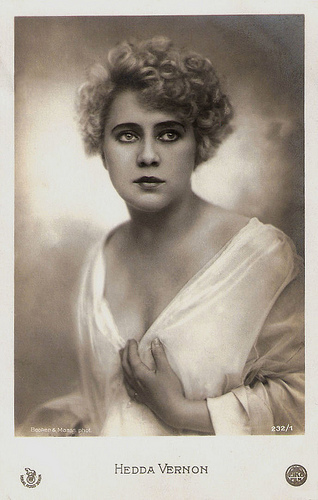
German postcard by Rotophot in the Film Sterne series, no. 232/1. Photo: Becker & Maass / Eiko-Film.
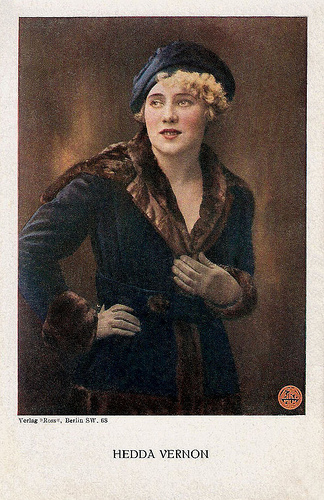
German postcard by Ross Verlag, Berlin, no. 2001/12, 1919-1924. Photo: Becker & Maass / Eiko Film.
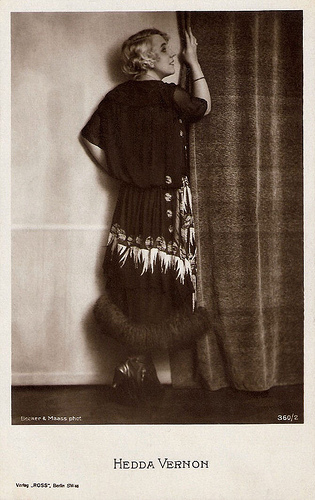
German postcard by Ross Verlag, no. 360/2, 1919-1924. Photo: Becker & Maass Phot.
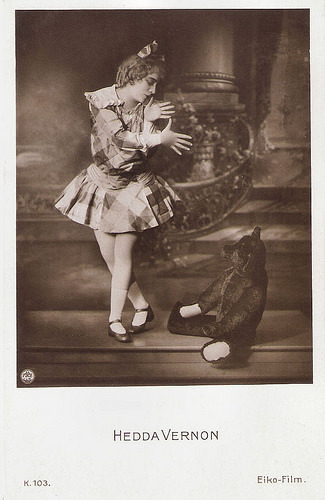
German postcard by Photochemie, Berlin, no. K. 103. Photo: Eiko-Film.
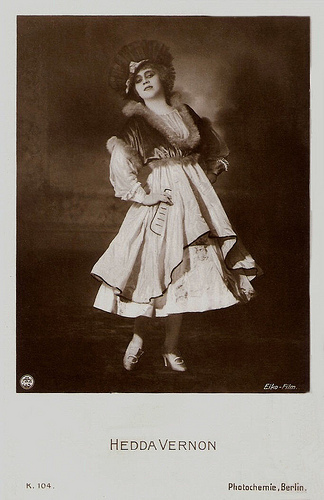
German postcard by Photochemie, Berlin, no. K. 104. Photo: Eiko-Film.
Child Parts
Hedda Vernon (sometimes credited as Hedda Vernon-Moest) was born in 1886.
In 1912 she made her first film appearances in silent shorts for the Deutsche Bioscop GmbH in Berlin. That year she appeared in Die Papierspur/The Paper Trail (Emil Albes, 1912), Die Rote Jule/Red Jule (Emil Albes, 1912) and Der Kampf um das Erbe/The Conflict about the Heritage (Max Obal, 1912).
The following years, she played in Vitascope productions directed by Harry Piel , like Menschen und Masken 1 & 2/People and Masks 1 and 2 (Harry Piel, 1913), Die Millionenmine/The Millions Mine (Harry Piel, 1914) and Die braune Bestie/The Brown Beast (Harry Piel, 1914).
But she worked most often with her husband, actor-director Hubert Moest. They made a series of Eiko-productions, including Zofenstreichen/Abigail Paintings (Hubert Moest, 1915), Maria Niemand und Ihre Zwölf Väter/Maria Nobody and Her Twelve Fathers (Hubert Moest, 1915) with Theodor Loos , and Das Bild der Ahnfrau/The Picture of the Ancestress (Hubert Moest, 1916) with Rudolf Forster and Harry Liedtke.
These were followed by Noemi die blonde Judin/Noemi the Blonde Jew (Hubert Moest, 1917), Der Peitschenhieb/The Whiplash (Hubert Moest, 1918), and Taumel/Rapture (Hubert Moest, 1919) with Alfred Abel and Paul Hartmann .
In Zofia (Hubert Moest, 1915), Hedda Vernon impersonated a fifteen year old girl although she was almost 29 at the time. Such ‘child parts’ were normal for actresses in the 1910s and 1920s.
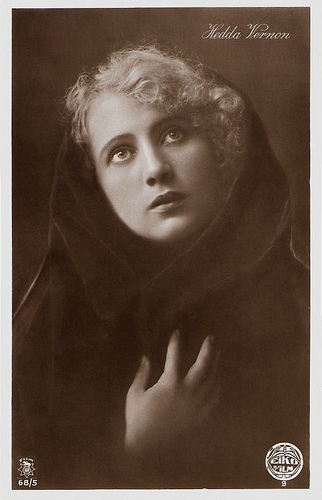
German postcard by Rotophot in the Film Sterne series, no. 68/5. Photo: Eiko-Film.
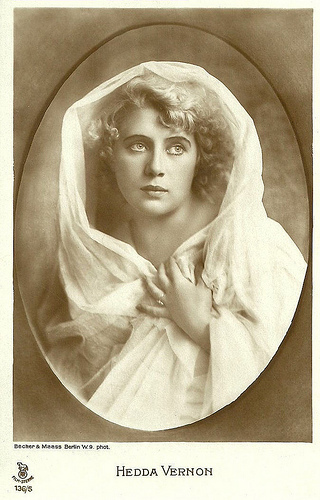
German postcard by Rotophot in the Film Sterne Series, no. 136/5. Photo: Becker & Maass, Berlin.
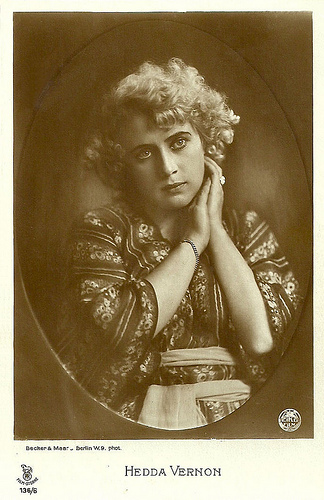
German postcard by Rotophot in the Film-Sterne Series, no. 138/6. Photo Becker & Maass, Berlin / Eiko Film.
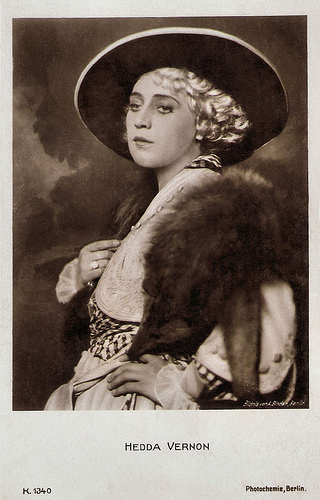
German postcard by Photochemie, Berlin, no. K. 1340. Photo: Alex Binder.
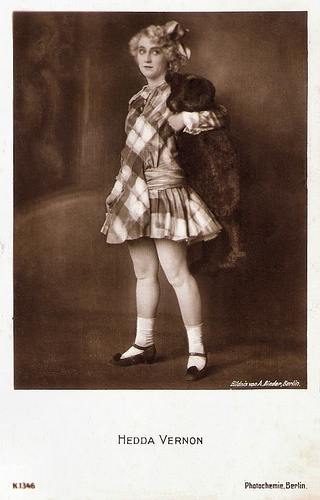
German postcard by Photochemie, no. K. 1346. Photo: Alex Binder.
Harry Piel Series
Hedda Vernon became so popular that she got her own serial which was financed by her production company Vernon-Produktion. She produced herself in Selbstgerichtet oder Die gelbe Fratze/Self Defence or The Yellow Grimace (Hubert Moest, 1914) and Hedda Vernon’s Bühnensketch/Hedda Vernon's Stage Sketch (Hubert Moest, 1916).
She also worked with director Richard Oswald on Der Eiserne Kreuz/The Iron Cross (1914) with Hanni Weisse , Der Tod des andern/Other's Death (1919) with Alwin Neuss , and Manolescus Memoiren/The Memories of Manolescu (1920) starring Conrad Veidt .
During the 1920s, the interest in Hedda Vernon flagged. New stars became more in demand. To her few films in the 1920s belong Der Verächter des Todes/The Death Defier (Harry Piel, 1920), the Harry Piel series Der Reiter ohne Kopf/The Horseman Without a Head (Harry Piel, 1921) and Die Sonne von St. Moritz/The Sun of St. Moritz (Friedrich Weissenberg, Hubert Moest, 1923).
Her last film was Zwischen zwei Frauen/Between Two Women (Hubert Moest, 1925) opposite Reinhold Schünzel .
Hedda Vernon died that same year, at an unknown location, and of unknown causes. She was married with producer-director Hubert Moest from 1913 till 1920.
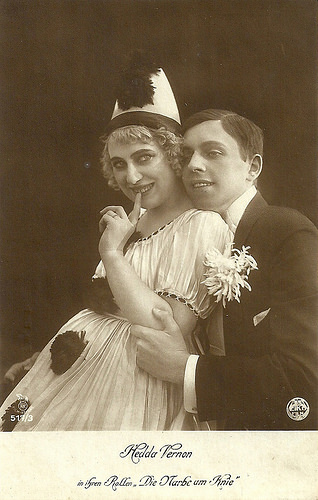
German postcard by Rotophot in the Film-Sterne series, no. 517/3. Photo: Eiko-Film. Hedda Vernon in Die Narbe am Knie (Hubert Moest, 1917).
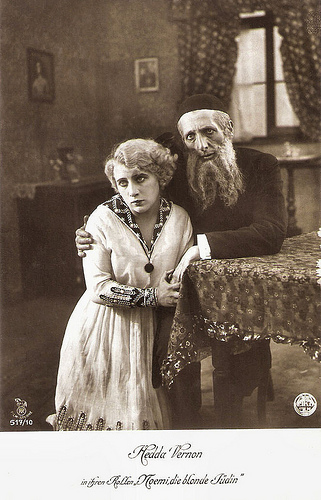
German postcard by Rotophot in the Film-Sterne series, no. 517/10. Photo: Eiko Film. Publicity still of Hedda Vernon in Noemi, die blonde Jüdin (Hubert Moest, 1917).
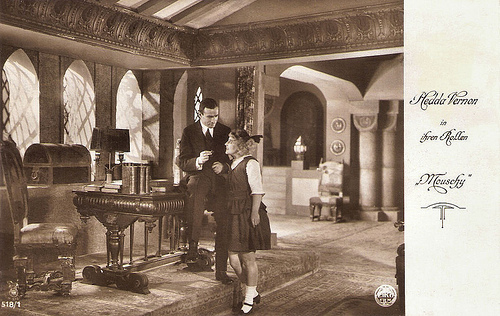
German postcard by Rotophot in the Film-Sterne series, no. 518/1. Photo: Eiko Film. Hedda Vernon in Mouschy (Hubert Moest, 1918).
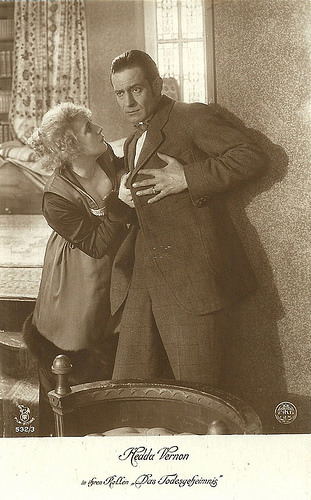
German postcard by Rotophot in the Film-Sterne series, no. 532/3. Photo: Eiko Film. Hedda Vernon and Erich Kaiser-Titz in Das Todesgeheimnis (Hubert Moest, 1918). Vernon co-scripted this film, with Ruth Goetz - who wrote several scripts for the Hedda Vernon films of the late 1910s.
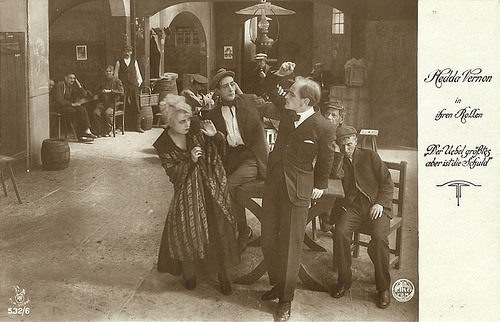
German postcard by Rotophot in the Film-Sterne series, no. 532/6. Photo: Eiko Film. Hedda Vernon in Der Übel größtes aber ist die Schuld (Hubert Moest, 1918).
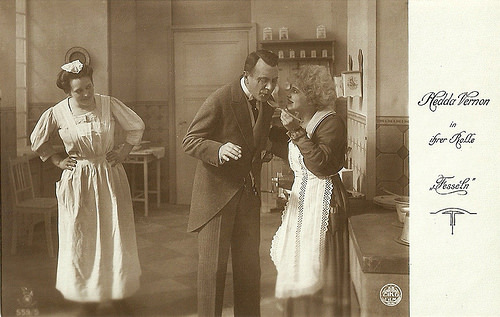
German postcard by Rotophot in the Film-Sterne series, no. 559/5. Photo: Eiko Film. Hedda Vernon in Fesseln/Chains (Hubert Moest, 1918).
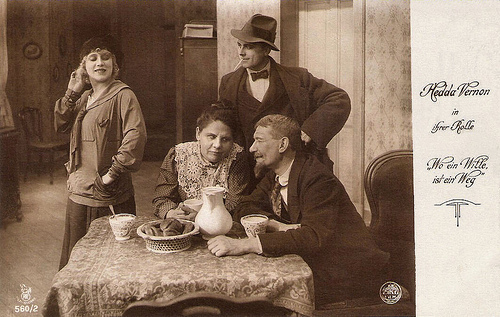
German postcard by Rotophot in the Film Sterne Series, no. 560/2. Photo: Eiko Film. Publicity still for Wo ein Wille, ist ein Weg (Hubert Moest, 1918) with in the back right Ernst Hofmann .
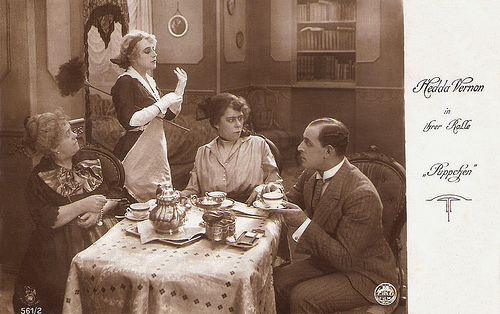
German postcard by Rotophot in the Film-Sterne series, no. 561/2. Photo: Eiko Film. Hedda Vernon in Puppchen/Dolly (Hubert Moest, 1918).
Sources: Thomas Staedeli (Cyranos), Filmportal.de, Wikipedia (German) and .

German postcard by Rotophot in the Film Sterne series, no. 232/1. Photo: Becker & Maass / Eiko-Film.

German postcard by Ross Verlag, Berlin, no. 2001/12, 1919-1924. Photo: Becker & Maass / Eiko Film.

German postcard by Ross Verlag, no. 360/2, 1919-1924. Photo: Becker & Maass Phot.

German postcard by Photochemie, Berlin, no. K. 103. Photo: Eiko-Film.

German postcard by Photochemie, Berlin, no. K. 104. Photo: Eiko-Film.
Child Parts
Hedda Vernon (sometimes credited as Hedda Vernon-Moest) was born in 1886.
In 1912 she made her first film appearances in silent shorts for the Deutsche Bioscop GmbH in Berlin. That year she appeared in Die Papierspur/The Paper Trail (Emil Albes, 1912), Die Rote Jule/Red Jule (Emil Albes, 1912) and Der Kampf um das Erbe/The Conflict about the Heritage (Max Obal, 1912).
The following years, she played in Vitascope productions directed by Harry Piel , like Menschen und Masken 1 & 2/People and Masks 1 and 2 (Harry Piel, 1913), Die Millionenmine/The Millions Mine (Harry Piel, 1914) and Die braune Bestie/The Brown Beast (Harry Piel, 1914).
But she worked most often with her husband, actor-director Hubert Moest. They made a series of Eiko-productions, including Zofenstreichen/Abigail Paintings (Hubert Moest, 1915), Maria Niemand und Ihre Zwölf Väter/Maria Nobody and Her Twelve Fathers (Hubert Moest, 1915) with Theodor Loos , and Das Bild der Ahnfrau/The Picture of the Ancestress (Hubert Moest, 1916) with Rudolf Forster and Harry Liedtke.
These were followed by Noemi die blonde Judin/Noemi the Blonde Jew (Hubert Moest, 1917), Der Peitschenhieb/The Whiplash (Hubert Moest, 1918), and Taumel/Rapture (Hubert Moest, 1919) with Alfred Abel and Paul Hartmann .
In Zofia (Hubert Moest, 1915), Hedda Vernon impersonated a fifteen year old girl although she was almost 29 at the time. Such ‘child parts’ were normal for actresses in the 1910s and 1920s.

German postcard by Rotophot in the Film Sterne series, no. 68/5. Photo: Eiko-Film.

German postcard by Rotophot in the Film Sterne Series, no. 136/5. Photo: Becker & Maass, Berlin.

German postcard by Rotophot in the Film-Sterne Series, no. 138/6. Photo Becker & Maass, Berlin / Eiko Film.

German postcard by Photochemie, Berlin, no. K. 1340. Photo: Alex Binder.

German postcard by Photochemie, no. K. 1346. Photo: Alex Binder.
Harry Piel Series
Hedda Vernon became so popular that she got her own serial which was financed by her production company Vernon-Produktion. She produced herself in Selbstgerichtet oder Die gelbe Fratze/Self Defence or The Yellow Grimace (Hubert Moest, 1914) and Hedda Vernon’s Bühnensketch/Hedda Vernon's Stage Sketch (Hubert Moest, 1916).
She also worked with director Richard Oswald on Der Eiserne Kreuz/The Iron Cross (1914) with Hanni Weisse , Der Tod des andern/Other's Death (1919) with Alwin Neuss , and Manolescus Memoiren/The Memories of Manolescu (1920) starring Conrad Veidt .
During the 1920s, the interest in Hedda Vernon flagged. New stars became more in demand. To her few films in the 1920s belong Der Verächter des Todes/The Death Defier (Harry Piel, 1920), the Harry Piel series Der Reiter ohne Kopf/The Horseman Without a Head (Harry Piel, 1921) and Die Sonne von St. Moritz/The Sun of St. Moritz (Friedrich Weissenberg, Hubert Moest, 1923).
Her last film was Zwischen zwei Frauen/Between Two Women (Hubert Moest, 1925) opposite Reinhold Schünzel .
Hedda Vernon died that same year, at an unknown location, and of unknown causes. She was married with producer-director Hubert Moest from 1913 till 1920.

German postcard by Rotophot in the Film-Sterne series, no. 517/3. Photo: Eiko-Film. Hedda Vernon in Die Narbe am Knie (Hubert Moest, 1917).

German postcard by Rotophot in the Film-Sterne series, no. 517/10. Photo: Eiko Film. Publicity still of Hedda Vernon in Noemi, die blonde Jüdin (Hubert Moest, 1917).

German postcard by Rotophot in the Film-Sterne series, no. 518/1. Photo: Eiko Film. Hedda Vernon in Mouschy (Hubert Moest, 1918).

German postcard by Rotophot in the Film-Sterne series, no. 532/3. Photo: Eiko Film. Hedda Vernon and Erich Kaiser-Titz in Das Todesgeheimnis (Hubert Moest, 1918). Vernon co-scripted this film, with Ruth Goetz - who wrote several scripts for the Hedda Vernon films of the late 1910s.

German postcard by Rotophot in the Film-Sterne series, no. 532/6. Photo: Eiko Film. Hedda Vernon in Der Übel größtes aber ist die Schuld (Hubert Moest, 1918).

German postcard by Rotophot in the Film-Sterne series, no. 559/5. Photo: Eiko Film. Hedda Vernon in Fesseln/Chains (Hubert Moest, 1918).

German postcard by Rotophot in the Film Sterne Series, no. 560/2. Photo: Eiko Film. Publicity still for Wo ein Wille, ist ein Weg (Hubert Moest, 1918) with in the back right Ernst Hofmann .

German postcard by Rotophot in the Film-Sterne series, no. 561/2. Photo: Eiko Film. Hedda Vernon in Puppchen/Dolly (Hubert Moest, 1918).
Sources: Thomas Staedeli (Cyranos), Filmportal.de, Wikipedia (German) and .
Published on June 22, 2018 22:00
June 21, 2018
Helene Thimig
Austrian actress Helene Thimig (1889-1974) was an important stage performer during the Weimar republic. She came from a renown acting family: she was the daughter of Hugo Thimig and the sister of Hermann Thimig and Hans Thimig. She fled the Nazis with her later husband, theatre producer/director Max Reinhardt, sought refuge in Hollywood, and appeared in 18 Hollywood films. After the war, she returned to Vienna where she had a prolific stage career but only sporadically appeared in films.

German postcard by Verlag Herm. Leiser, Berlin-Wilm., no. 6895. Photo: Rembrandt Atelier.
Love Affair with Max Reinhardt
Helene Ottilie Thimig was born in Wien (Vienna) in 1889. She was the daughter of the later Burgtheater director Hugo Thimig and his wife Franziska née. Hummel. Her two brothers Hermann Thimig and Hans Thimig also became actors.
After elementary school and the Lyceum Luithlen she took acting lessons with Hedwig Bleibtreu. In 1907 she had her first appearance in the Stadttheater of Baden as Marthe in Edouard Pailleron's The Mouse.
In 1908 she played Melissa in Franz Grillparzer's Sappho at the Goethe Festival in Dusseldorf, then she acted at the Hoftheater (Court Theatre) in Meiningen, and from 1911 to 1917 at the Königlichen Schauspielhaus (Royal Playhouse) in Berlin.
In 1917 she received an engagement at the Deutschen Theater (German Theatre) in Berlin, where she debuted as Elsalil in Gerhart Hauptmann's Winterballade (Winter Ballad).
From the beginning, a close cooperation and love affair developed between her and Max Reinhardt, director of the Deutschen Theater. He was married to actress Else Heims and had two sons with her. Thimig was married to the director Paul Kalbeck from 1916 to 1918.
She made her film debut in the drama Mensch ohne Namen/Man Without a Name (Gustav Ucicky, 1932) starring Werner Krauss . When Reinhardt was ostracised after the Nazis came to power in 1933, Thimig's successful stage career in Berlin also came to an end. She followed Reinhardt to Vienna and performed at the Theater in der Josefstadt, which Reinhardt directed. Further performances followed in Prague and at the Salzburg Festival.
Thimig followed Reinhardt to various productions in several European countries and after his divorce, they were married in Nevada in May 1935 during a guest appearance in the United States. At the end of October 1937 she finally joined Reinhardt in his American exile. Since she learned the English language slowly, she received for a long time only very small roles in American theatre and film productions.
Between 1942 and 1947 she appeared in 18 Hollywood films, in which she represented mostly German women. These included The Gay Sisters (Irving Rapper, 1942) starring Barbara Stanwyck, the pseudo-documentary The Hitler Gang (John Farrow, 1944), The Seventh Cross (Fred Zinnemann, 1944), starring Spencer Tracy, and the Film Noir Cloak and Dagger (Fritz Lang, 1946), starring Gary Cooper.
In 1943, Max Reinhardt died.
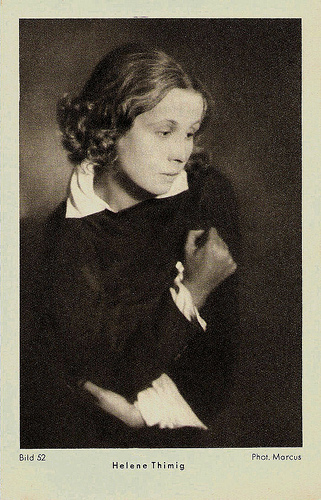
German postcard by Margarinewerk Eidelstedt Gebr. Fauser G.m.b.H., Holstein, Serie 1, no. Bild 52. Photo: Marcus.
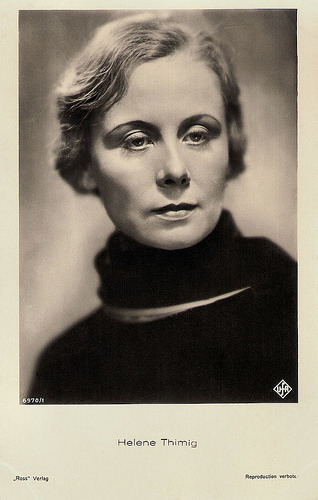
German postcard by Ross Verlag, no. 6970/1, 1931-1932. Photo: Ufa. Publicity still for Mensch ohne Namen/The Man Without a Name (Gustav Ucicky, 1932).
A Return to Europe
After the end of the Second World War, Helene Thimig returned to Europe. She appeared in a few films, including the Austrian film Der Engel mit der Posaune/The Angel with the Trumpet (Karl Hartl, 1948). In Austria she became a member of the Burgtheater, where in 1950 she was awarded the honorary title of a Kammerschauspielerin (chamber actress).
In 1948 she entered into a third marriage with the Austrian actor Anton Edthofer. Between 1947 and 1951 she staged Hugo von Hofmannsthal's Jedermann (Everyman) at the Salzburg Festival and directed the Viennese Max Reinhardt Seminar from 1948 to 1954. In addition, she took on a teaching position as a professor at the Academy of Music and Performing Arts.
In the cinema, however, she received only a few tasks, including a role in the American production Decision Before Dawn (Anatole Litvak, 1951), starring Richard Basehart and Oskar Werner , and the German drama Waldwinter/Winter in the Woods (Wolfgang Liebeneiner, 1956), starring Claus Holm .
After leaving the Burgtheater ensemble in 1954, she again took on a firm commitment at the Theater in der Josefstadt. From 1963 to 1968 she again staged Jedermann at the Salzburg Festival. At the end of March 1974 she was on stage for the last time in Josefstadt.
In November 1974, Helene Thimig-Reinhardt died in her native Vienna of heart failure at the age of 85. She was cremated in the crematorium Feuerhalle Simmering and buried in an honorary dedicated urn.
In 2015, the urn with her ashes was moved to a grave dedicated to the honour of the Neustift cemetery. In 2016, the Helene-Thimig-Weg was named after her in Vienna Liesing. Thimig received prizes and awards, including the Josef-Kainz-Medaille in 1962 and the Ring of Honour of the City of Vienna in 1969.
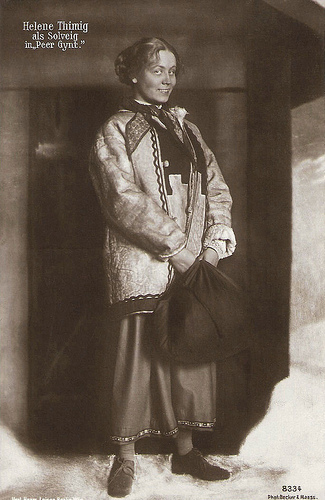
German postcard by Verlag Herm. Leiser, Berlin-Wilm., no. 8334. Photo: Becker & Maass. Caption: Helen Thimig as Solveig in Peer Gynt. Thimig appeared in the play by Henrik Ibsen in 1914.
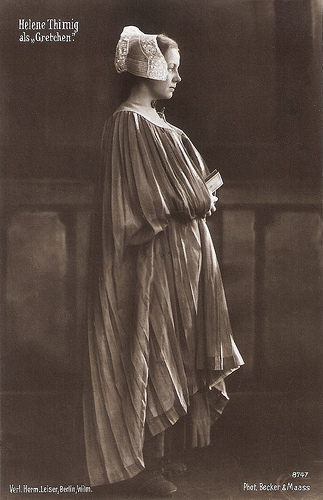
German postcard by Verlag Herm. Leiser, Berlin-Wilm., no. 8747. Photo: Becker & Maass. Publicity still for Max Reinhardt's stage production of Goethe's Faust (1920) with Helene Thimig as Gretchen.
Sources: Wikipedia (German and English) and .

German postcard by Verlag Herm. Leiser, Berlin-Wilm., no. 6895. Photo: Rembrandt Atelier.
Love Affair with Max Reinhardt
Helene Ottilie Thimig was born in Wien (Vienna) in 1889. She was the daughter of the later Burgtheater director Hugo Thimig and his wife Franziska née. Hummel. Her two brothers Hermann Thimig and Hans Thimig also became actors.
After elementary school and the Lyceum Luithlen she took acting lessons with Hedwig Bleibtreu. In 1907 she had her first appearance in the Stadttheater of Baden as Marthe in Edouard Pailleron's The Mouse.
In 1908 she played Melissa in Franz Grillparzer's Sappho at the Goethe Festival in Dusseldorf, then she acted at the Hoftheater (Court Theatre) in Meiningen, and from 1911 to 1917 at the Königlichen Schauspielhaus (Royal Playhouse) in Berlin.
In 1917 she received an engagement at the Deutschen Theater (German Theatre) in Berlin, where she debuted as Elsalil in Gerhart Hauptmann's Winterballade (Winter Ballad).
From the beginning, a close cooperation and love affair developed between her and Max Reinhardt, director of the Deutschen Theater. He was married to actress Else Heims and had two sons with her. Thimig was married to the director Paul Kalbeck from 1916 to 1918.
She made her film debut in the drama Mensch ohne Namen/Man Without a Name (Gustav Ucicky, 1932) starring Werner Krauss . When Reinhardt was ostracised after the Nazis came to power in 1933, Thimig's successful stage career in Berlin also came to an end. She followed Reinhardt to Vienna and performed at the Theater in der Josefstadt, which Reinhardt directed. Further performances followed in Prague and at the Salzburg Festival.
Thimig followed Reinhardt to various productions in several European countries and after his divorce, they were married in Nevada in May 1935 during a guest appearance in the United States. At the end of October 1937 she finally joined Reinhardt in his American exile. Since she learned the English language slowly, she received for a long time only very small roles in American theatre and film productions.
Between 1942 and 1947 she appeared in 18 Hollywood films, in which she represented mostly German women. These included The Gay Sisters (Irving Rapper, 1942) starring Barbara Stanwyck, the pseudo-documentary The Hitler Gang (John Farrow, 1944), The Seventh Cross (Fred Zinnemann, 1944), starring Spencer Tracy, and the Film Noir Cloak and Dagger (Fritz Lang, 1946), starring Gary Cooper.
In 1943, Max Reinhardt died.

German postcard by Margarinewerk Eidelstedt Gebr. Fauser G.m.b.H., Holstein, Serie 1, no. Bild 52. Photo: Marcus.

German postcard by Ross Verlag, no. 6970/1, 1931-1932. Photo: Ufa. Publicity still for Mensch ohne Namen/The Man Without a Name (Gustav Ucicky, 1932).
A Return to Europe
After the end of the Second World War, Helene Thimig returned to Europe. She appeared in a few films, including the Austrian film Der Engel mit der Posaune/The Angel with the Trumpet (Karl Hartl, 1948). In Austria she became a member of the Burgtheater, where in 1950 she was awarded the honorary title of a Kammerschauspielerin (chamber actress).
In 1948 she entered into a third marriage with the Austrian actor Anton Edthofer. Between 1947 and 1951 she staged Hugo von Hofmannsthal's Jedermann (Everyman) at the Salzburg Festival and directed the Viennese Max Reinhardt Seminar from 1948 to 1954. In addition, she took on a teaching position as a professor at the Academy of Music and Performing Arts.
In the cinema, however, she received only a few tasks, including a role in the American production Decision Before Dawn (Anatole Litvak, 1951), starring Richard Basehart and Oskar Werner , and the German drama Waldwinter/Winter in the Woods (Wolfgang Liebeneiner, 1956), starring Claus Holm .
After leaving the Burgtheater ensemble in 1954, she again took on a firm commitment at the Theater in der Josefstadt. From 1963 to 1968 she again staged Jedermann at the Salzburg Festival. At the end of March 1974 she was on stage for the last time in Josefstadt.
In November 1974, Helene Thimig-Reinhardt died in her native Vienna of heart failure at the age of 85. She was cremated in the crematorium Feuerhalle Simmering and buried in an honorary dedicated urn.
In 2015, the urn with her ashes was moved to a grave dedicated to the honour of the Neustift cemetery. In 2016, the Helene-Thimig-Weg was named after her in Vienna Liesing. Thimig received prizes and awards, including the Josef-Kainz-Medaille in 1962 and the Ring of Honour of the City of Vienna in 1969.

German postcard by Verlag Herm. Leiser, Berlin-Wilm., no. 8334. Photo: Becker & Maass. Caption: Helen Thimig as Solveig in Peer Gynt. Thimig appeared in the play by Henrik Ibsen in 1914.

German postcard by Verlag Herm. Leiser, Berlin-Wilm., no. 8747. Photo: Becker & Maass. Publicity still for Max Reinhardt's stage production of Goethe's Faust (1920) with Helene Thimig as Gretchen.
Sources: Wikipedia (German and English) and .
Published on June 21, 2018 22:00
June 20, 2018
Das alte Gesetz (1923)
Although Henny Porten had only a supporting part in Das alte Gesetz/The Ancient Law (1923) and Ernst Deutsch had the leading role, she was the main subject on the series of postcards which Ross Verlag made for the film. Photographer Hans Natge made the beautiful stills for the this silent film production by Comedia Film, directed by Ewald André Dupont.
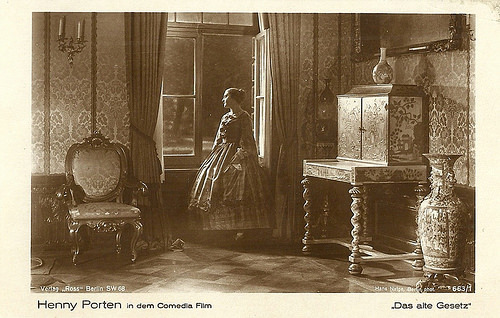
German postcard by Ross Verlag, no. 663/1. Photo: Hans Natge, Berlin / Comedia Film. Publicity still of Henny Porten in Das alte Gesetz (E.A. Dupont, 1923).
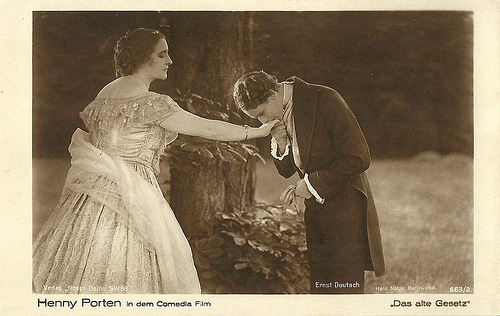
German postcard by Ross Verlag, no. 663/2. Photo: Hans Natge, Berlin / Comedia Film. Publicity still of Henny Porten and Ernst Deutsch in Das alte Gesetz (E.A. Dupont, 1923).
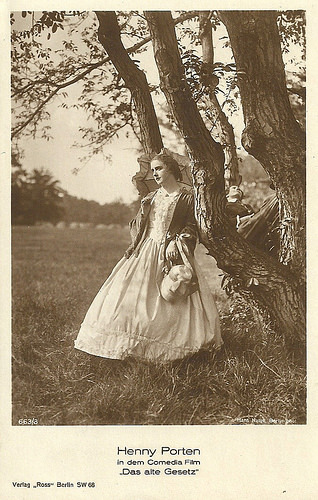
German postcard by Ross Verlag, no. 663/3. Photo: Hans Natge, Berlin / Comedia Film. Publicity still of Henny Porten in Das alte Gesetz (E.A. Dupont, 1923).
He recognises God's mercy in the performance of his son
In Das alte Gesetz/The Ancient Law (E.A. Dupont, 1923), Ernst Deutsch plays the mid-19th century rabbi's son Baruch Mayer, who decides to break with the family tradition. Against his orthodox father's will, he leaves his shtetl in Galicia to become an actor.
Baruch joins a small wandering burlesque company. The Austrian archduchess Elisabeth Theresia ( Henny Porten ) discovers him there and becomes enarmoured with him. Secretly in love with him, she provides him an engagement at the Burgtheater, the most important theatre in Vienna.
Baruch receives a contract at the Burgtheater and soon manages to become a celebrated star. More and more he becomes an assimilated jew, but his relation with the grand-duchess isn't approved by the Austrian court, so they have to end it.
His father Rabbi Mayer (Avrom Morewski) is appalled by this life and rejects his son, but when he witnesses a performance of his son as Don Carlos, he is so impressed by his talent, he recognises God's mercy in this and pardons his son.
Baruch returns to his eastern European shtetl where he grew up and where his sweetheart from his youth (Margarete Schlegel) has waited for him all the time...
With its complex portrayal of orthodoxy and emancipation, Ewald André Dupont's period film marks a highpoint of Jewish filmmaking in Germany, according to film historians.
Das alte Gesetz was scripted by Paul Reno. The story precedes the similar plot of the more famous American sound film The Jazz Singer (Alan Crossland, 1927) with Al Jolson, which was made just a few years after,
Cinematography of Das alte Gesetz was done by Thomas Spahrkuhl and the sets were designed by Alfred Junge, and executed by Curt Kahle, while the costumes were designed by Ali Hubert.
The film premiered in Berlin on 29 October 1923. The German press praised the film: "Dupont manages to visualise these two so different worlds, the ghetto milieu, which is separated from the outer world by a sheer insurmountable wall, and this world itself; the Vienna of the 1860's, led by the rhythms of Strauss' valzer and epitomized by the Burgtheater as artistic summit." (Film-Kurier, no. 244, 30 October 1923)
Various prints of the films existed, which were quite different from each other and not always respected the original. The Deutsche Kinemathek recently did a full restoration and the restored, 135 minutes long version of the film was shown with live accompaniment on 16 February 2018 at the Friedrichstadt - Palast at the Berlinale 2018. Three days later it was showed on Arte TV.
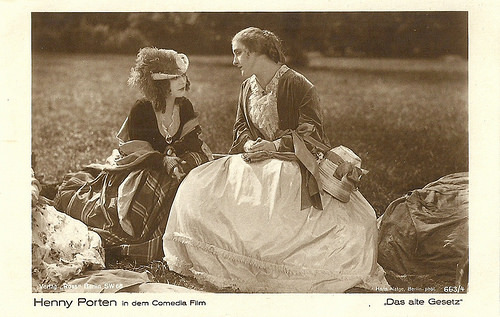
German postcard by Ross Verlag, no. 663/4. Photo: Hans Natge, Berlin / Comedia Film. Publicity still of Henny Porten in Das alte Gesetz (E.A. Dupont, 1923).
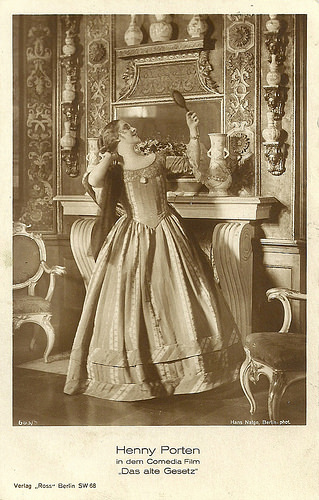
German postcard by Ross Verlag, no. 663/5. Photo: Hans Natge, Berlin / Comedia Film. Publicity still of Henny Porten in Das alte Gesetz (E.A. Dupont, 1923).
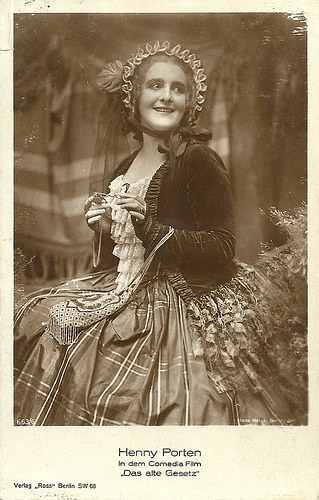
German postcard by Ross Verlag, no. 663/6. Photo: Hans Natge, Berlin / Comedia Film. Publicity still of Henny Porten in Das alte Gesetz (E.A. Dupont, 1923).
Sources: epd-film.de, Filmportal.de, Wikipedia (English and German) and IMDb.

German postcard by Ross Verlag, no. 663/1. Photo: Hans Natge, Berlin / Comedia Film. Publicity still of Henny Porten in Das alte Gesetz (E.A. Dupont, 1923).

German postcard by Ross Verlag, no. 663/2. Photo: Hans Natge, Berlin / Comedia Film. Publicity still of Henny Porten and Ernst Deutsch in Das alte Gesetz (E.A. Dupont, 1923).

German postcard by Ross Verlag, no. 663/3. Photo: Hans Natge, Berlin / Comedia Film. Publicity still of Henny Porten in Das alte Gesetz (E.A. Dupont, 1923).
He recognises God's mercy in the performance of his son
In Das alte Gesetz/The Ancient Law (E.A. Dupont, 1923), Ernst Deutsch plays the mid-19th century rabbi's son Baruch Mayer, who decides to break with the family tradition. Against his orthodox father's will, he leaves his shtetl in Galicia to become an actor.
Baruch joins a small wandering burlesque company. The Austrian archduchess Elisabeth Theresia ( Henny Porten ) discovers him there and becomes enarmoured with him. Secretly in love with him, she provides him an engagement at the Burgtheater, the most important theatre in Vienna.
Baruch receives a contract at the Burgtheater and soon manages to become a celebrated star. More and more he becomes an assimilated jew, but his relation with the grand-duchess isn't approved by the Austrian court, so they have to end it.
His father Rabbi Mayer (Avrom Morewski) is appalled by this life and rejects his son, but when he witnesses a performance of his son as Don Carlos, he is so impressed by his talent, he recognises God's mercy in this and pardons his son.
Baruch returns to his eastern European shtetl where he grew up and where his sweetheart from his youth (Margarete Schlegel) has waited for him all the time...
With its complex portrayal of orthodoxy and emancipation, Ewald André Dupont's period film marks a highpoint of Jewish filmmaking in Germany, according to film historians.
Das alte Gesetz was scripted by Paul Reno. The story precedes the similar plot of the more famous American sound film The Jazz Singer (Alan Crossland, 1927) with Al Jolson, which was made just a few years after,
Cinematography of Das alte Gesetz was done by Thomas Spahrkuhl and the sets were designed by Alfred Junge, and executed by Curt Kahle, while the costumes were designed by Ali Hubert.
The film premiered in Berlin on 29 October 1923. The German press praised the film: "Dupont manages to visualise these two so different worlds, the ghetto milieu, which is separated from the outer world by a sheer insurmountable wall, and this world itself; the Vienna of the 1860's, led by the rhythms of Strauss' valzer and epitomized by the Burgtheater as artistic summit." (Film-Kurier, no. 244, 30 October 1923)
Various prints of the films existed, which were quite different from each other and not always respected the original. The Deutsche Kinemathek recently did a full restoration and the restored, 135 minutes long version of the film was shown with live accompaniment on 16 February 2018 at the Friedrichstadt - Palast at the Berlinale 2018. Three days later it was showed on Arte TV.

German postcard by Ross Verlag, no. 663/4. Photo: Hans Natge, Berlin / Comedia Film. Publicity still of Henny Porten in Das alte Gesetz (E.A. Dupont, 1923).

German postcard by Ross Verlag, no. 663/5. Photo: Hans Natge, Berlin / Comedia Film. Publicity still of Henny Porten in Das alte Gesetz (E.A. Dupont, 1923).

German postcard by Ross Verlag, no. 663/6. Photo: Hans Natge, Berlin / Comedia Film. Publicity still of Henny Porten in Das alte Gesetz (E.A. Dupont, 1923).
Sources: epd-film.de, Filmportal.de, Wikipedia (English and German) and IMDb.
Published on June 20, 2018 22:00
Paul van Yperen's Blog
- Paul van Yperen's profile
- 13 followers
Paul van Yperen isn't a Goodreads Author
(yet),
but they
do have a blog,
so here are some recent posts imported from
their feed.



